

REDISA

Find out how Pikitup keeps Joburg clean
ARE INSECTS THE KEY SECURING GLOBAL FOOD PRODUCTION?
HOW DOES SOUTH AFRICA MANAGE ITS NUCLEAR WASTE?
Industrial symbioses brings businesses together for a circular goal






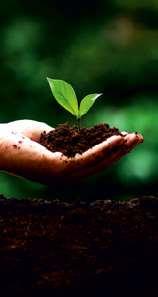


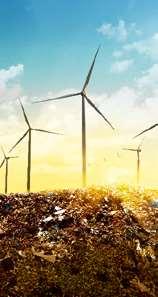

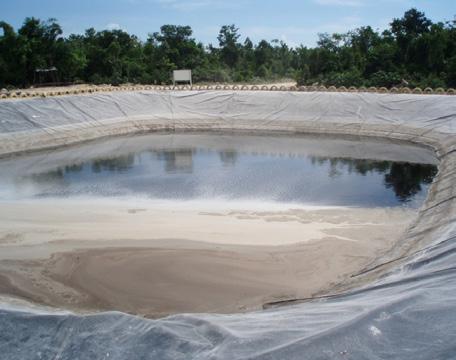



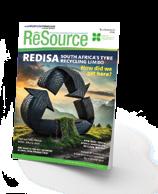
Between the years 2023-2017, the Recycling and Economic Development Initiative of South Africa (REDISA) managed the collection and recycling of South Africa’s tyres. During this time, the company managed 250 000 tyres per year. P4
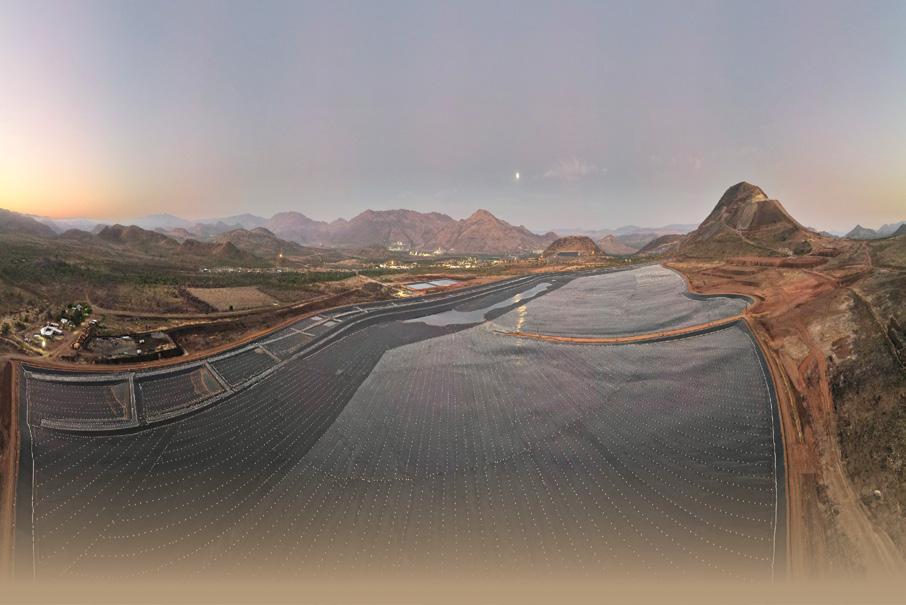










Managing Editor: Kirsten Kelly kirsten@infrastructurenews.co.za
Editor: Duncan Nortier duncan@infrastructurenews.co.za
Digital Manager: Reg Barichievy, Bhekisisa Centre for Health Journalism digital@infrastructurenews.co.za
Designer: Beren Bauermeister
Contributor: Hugh Tyrell
Advertising Sales: Sindi Moni
c +27 (0)82 212 4574 sindi@infrastructurenews.co.za
Publisher Infrastructure News
47 Grove Road, Orange Grove, Johannesburg Gauteng, 2192
Tel: +27 (0)83 433 4475 www.infrastructurenews.co.za
The official journal of the

Institute of Waste Management of Southern Africa
Tel +27 (0)11 675 3462
Email iwmsa@iwmsa.co.za
Annual subscription kirsten@infrastructurenews.co.za
R200.00 (incl VAT) South Africa ISSN 1680-4902
Copyright 2025. All rights reserved. All material herein is copyright protected. The views of contributors do not necessarily reflect those of IWMSA or the publishers.
All material herein is copyright protected and may not be reproduced either in whole or in part without the prior written permission of the publisher. The views and opinions of authors expressed in the magazine do not necessarily reflect those of the publisher, editor or the Institute of Waste Management of Southern Africa.


Buzzwords, bingo, and the end of the world
There was a time before anyone had heard of ‘the circular economy’, but you would have never guessed it from the complete and ubiquitous adoption of the term.
Borrowing from nature, the circular economy aims to replicate ecological processes that minimise waste, and as a concept, it’s rather good. I am, however, always sceptical of sudden uptakes in vocabulary, because while the circular economy is founded on proper scientific rigour, it risks becoming a buzzword.
There are certain words or phrases that get thrown around so much that they effectively lose all real meaning; they become a placeholder for a platitude. This happened to ‘sustainability’, where every second company labelled itself as ‘sustainable’ without changing anything. If you paint your business green, you don’t have a green business. And as greenwashing came to public light, the word sustainable became meaningless.
Climate change is also one of those words where you can’t be a hundred per cent sure what the person saying it means without them explaining it. We all know climate change refers to the manmade shift in global weather patterns that, if unchecked, will leave a scar on the world and greatly shrink nature’s capacity for human hospitality, yet whenever someone







mentions climate change, you have to double back to see if they are serious or silly (read: in denial).
You can play bingo at conferences with these words. Climate change, sustainability, circularity, carbon footprint, etc. But that would be cynical, and the waste sector of South Africa is not and can’t afford to be cynical.
Instead, as the experts in this field, the waste sector can act as BS detectors. We need to stand by these words and ideas and protect them. Ensure they are used correctly, and call into question any dubious activities punted as circular. We need to reclaim our hard-earned words like ‘sustainable’ and prove that the idea of improving the world is not dead.
You will read the words ‘circular economy’ many times in this publication, and each time you read it, you can be assured that we mean it.

DuncanCOVER OPPORTUNITY
In each issue, ReSource offers companies the opportunity to get to the front of the line by placing a company, product or service on the front cover of the magazine. Buying this position will afford the advertiser the cover story and maximum exposure. For more information, contact Sindi Moni on +27 (0)82 212 4574, or email sindi@infrastructurenews.co.za.
South Africa’s tyre recycling limbo
how did we get here?
Between the years 2023-2017, the Recycling and Economic Development Initiative of South Africa (REDISA) managed the collection and recycling of South Africa’s tyres. During this time, the company managed 250 000 tyres per year.
In 2012, when the government approved our tyre strategy, REDISA managed to get on top of South Africa’s tyres. The country was seen as a leader in space. Now things look vastly different,” says Stacey Jansen, director of REDISA. During their stint, REDISA managed 250 000 tyres a year, and at the end of 2017, they had a 20 000 tonne backlog, something Jansen says,” was manageable.”
Now, South Africa has an estimated 900 000 tonne backlog of tyres, a stark increase and a shocking statistic showing how tyres become a problem if left unchecked.
REDISA’s process actively involved the informal elements of the waste industry, Jansen explains, “A substantial portion of the waste sector is informal. Instead of hiding from this, we envisioned mobilising this force and paying waste pickers directly to collect tyres. These tyres would then be taken to collection centres and then moved to a recycling centre when applicable. This caused irritation in the tyre industry because they did not have control of the
tyres, and ultimately this led to REDISA’s nonprofit status being withdrawn and the entity liquidated.” This was the catalyst for South Africa’s tyre collection programme to crumble.
In the interim
Since 2017 until now, South Africa has not implemented a plan to deal with its waste tyres. In 2024, the Department of Forestry, Fisheries and Environment (DFFE) approved its Industry Waste Tyre Management Plan (IWTMP), but the plan was not implemented, and, in REDISA’s view, “Completely backwards and unworkable.” Since then, REDISA approached the Pretoria High Court to review and set aside the IWTMP.
REDISA has gone on record stating that this plan is a severe step backwards. Jansen explains, “When you have a governing document like the IWTMP, it should be clear to every stakeholder and have actionable goals
Stacey Jansen, director of REDISA

Minister of Forestry, Fisheries, and Environmental Dr Dion George withdrew the national tyre plan, which REDISA welcomed this as a step forward

and mechanisms. This plan does not. Any plan that uses words like ‘should’ or ‘maybe’ is not strong and lacks accountability.”
Jansen says that the plan is unworkable due to:
• No accountability: The plan had overlapping actions where it was not clear who was responsible for what. This leads to a plan where people either do not know their
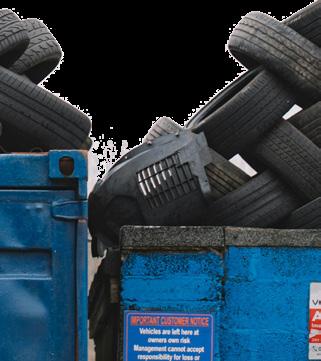


role, overstep their role, or avoid their role without accountability because the plan did not specify it.
• No budget: The plan’s budget was nonexistent. While the plan had numbers, none of these were attached to funding or mechanisms to activate this funding.
• Bad data: The IWTMP lacked cohesive data to back its claims and, in some cases, used incorrect data.
• No legislation: While the plan would fall under the National Waste Act, the plan did not cite any laws or regulations and provided no update to the existing policy in a way that acted on the plan’s goals.
• No reporting procedure: The plan mentions reporting, but the time frames suggested were either impossible or vague.
Jansen adds, “We did not file in court to be obtuse; we genuinely saw that this plan was not workable and wanted to intervene. The plan was approved in 2024, but there has been zero movement on it since. What we can see is that since 2017, the government has spent about R5 billion on tyre management in the face of no plan.

The present
In June 2025, the DFFE withdrew the IWTMP, and plans to reassess it to ensure that the plan aligns with the department’s sustainability goals and governance. Jansen says, “Of course, REDISA welcomes this decision; finally, sanity prevails! We can only hope the DFFE goes forward with a better plan, more in line with REDISA’s original plan, so that South Africa can actually deal with waste.
The future of tyre recycling in South Africa
Looking ahead, Jansen says, “research shows that valorising the 38 different waste streams in SA through recycling, could grow the economy by 1.75%. This growth would be underpinned by small and medium enterprises, which have the most potential to create employment.”
For South Africa to move forward, productively, REDISA suggest implementing the following actions:



• Provide financial incentives for tyre recycling.
• A real, actionable plan that clearly states who is responsible for what, with budget and reporting mechanisms.
• Understand that the waste sector relies on the informal economy as well as smaller enterprises.
• Increased accountability.
Jansen adds, “Waste should never be a noun. Between 2013 and 2017, South Africa had a working system for dealing with tyres. If recycling tyres were easy, it would already be done. We need to find a way to understand the market
and move the water up the value chain. This must be done with financial incentives to get the system moving and improve supply and manage demand. We were once leaders in this practice, and with a working plan, we can be again.”
South Africa’s tyre problem is currently in limbo, the IWTMP has been withdrawn, and the government is still managing tyres out of pocket. The decision to withdraw the ‘unworkable’ plan suggests a step in the right direction, but while plans are looked at and finalised, the 900 000 tonne backlog is still taking up space in landfills. These tyres represent a failure and an opportunity for South Africa to get behind its sustainability objectives.

Integrating the informal economy into recycling activities is necessary (image credit SAWPA)
REDISA built a R2.5 billion infrastructure network that is now in ruins







THE IMPORTANCE OF CONFERENCES, AND LISTENING
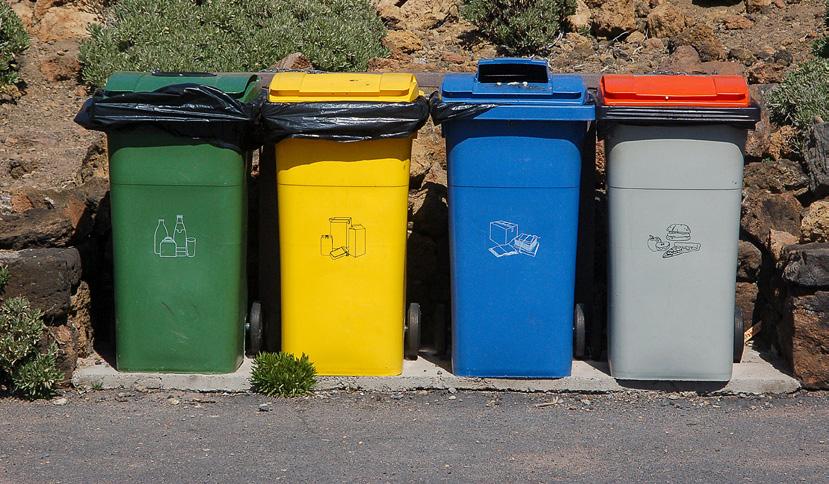
In May, the IWMSA hosted the Waste 360 conference. These conferences allow us to gather, speak one language, and find solutions to the problems that we all face. This conference, however, was a little more special because it wasn’t hosted in Johannesburg or Cape Town but rather the Eastern Cape.
The Eastern Cape is often left out of conversations, but this conference proves that the province is a power player. The passion and rigour displayed by the Eastern Cape branch of the IWMSA spoke volumes. Away from the usual hubs of Cape Town and Johannesburg, the East London event was a learning moment. We learned from companies and organisations that are doing exceptional work against the odds.
Those in the waste industry know that the informal economy and the township economy are significant to the sector. What we find in the Eastern Cape is not just an understanding of this but a way forward on how to engage these isolated economies in common interest. Townships are non-standard; they usually do not have the same service provision as formalised areas, and they require non-standard thinking and solutions. These townships are economic
hubs, and the people living there are just as ready and willing to have a cleaner, functional environment. Within the townships, numerous informal jobs emerge from waste, and wherever there are jobs, there is a corresponding need. Waste entrepreneurs are finding ways to collect, reuse, and recycle in areas that need the service.
What was also highlighted at the conference was the need and importance of community engagement. Communities are keen to work together if they understand the project and its positive benefits. We need to consider thinking outside of our cities and suburbs, and into the wider areas of South Africa if we are to make an impact.
Patricia Schröder, President, IWMSA
Conferences are necessary. They allow us to gather, but more importantly, they are teaching and learning spaces, and there are lessons to be learned from all over South Africa. We cannot afford not to listen if we truly care about waste management, taking lessons from wherever they come.
I would like to thank the IWMSA Eastern Cape Branch and its chair, Mervin Olivier, for a spectacular conference. The dedication and commitment you displayed are inspiring, and we take this forward with us as we tackle the issue of waste in South Africa.






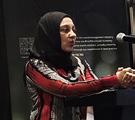



The Institute of Waste Management of Southern Africa (IWMSA) hosted the Waste 360 conference at their Eastern Cape branch under the theme ‘Any 360 requires starting from a solid foundation.’
This event was attended by waste management professionals, academics, entrepreneurs, and government stakeholders to celebrate real-world innovations, meaningful collaboration, and share visions of a more sustainable future.
Held from the 22nd to the 23rd of May 2025, the conference boasted insightful
5 “Voices from the E-Waste Repairers and Informal Used and Waste Tyre Dealers in South Africa’s Townships” delivered by Prof. Catherina Schenck and Prof. Derick Blaauw 5 2 4
technical presentations, inspiring success stories, and in-depth strategic discussions. South Africa’s transition to a circular economy is aided by the already existing and thriving waste management sector, and this conference only confirms the expertise and passion that will aid in South Africa’s ‘360’.
1 The keynote by Professor Linda Godfrey, titled "Unlocking circular economy opportunities in South Africa through Science, Technology and Innovation."
2 ”Diaper Disposal and Greener Alternatives” delivered by Dr Raeesa Moolla
3 “Generation of Insect Protein from Food Waste” delivered by Lowell Scarr
4 “Intro to IWMSA and EC Events” delivered by Patricia Schroder
The DNF school recycling awards
The annual Recycling Awards were given at the Waste 360 conference in the Eastern Cape. These awards celebrate the schools that made a significant effort to divert recyclable material from landfills. This year, schools diverted 29,492 kg of waste. IWMSA wishes to congratulate the schools involved and give a special mention to the top five schools for doing their part to preserve the environment for future generations.





Landfill site visit
The Western Cape branch of the IWMSA organised a visit to Wellington Landfill site on the 14th of May 2025. The vent highlighted the ongoing need for landfilling in South Africa as well as how these sites operate in a sustainable manner. Nicolle de Bruyn, executive officer at IWMSA, noted, “the weather was perfect, there was great interaction and networking, and 90% attendance.”
Landfill management in progress in Wellington


IWMSA recycling workshop
The IWMSA Central Branch, in collaboration with PETCO, Pikitup, and Fibre Circle, hosted a recycling workshop at the Deutsche Internationale Schule in Parktown, Johannesburg.
The school approached the IWMSA to facilitate a workshop as part of their Science Week, which focused on the themes of sustainability, the circular economy, the green economy, waste management, and recycling.
Th workshops were conducted over two days and involved four Grade 7 classes, with each session
lasting approximately 80 minutes. Learners were introduced to various recyclable materials and encouraged to take ownership of keeping their school environment clean. Although the school has a recycling station and colour-coded bins, learners and staff were not consistently separating waste. The workshops aimed to inspire a sense of responsibility in the school community.
As part of the upcoming Science Week project in June, the theme of sustainability will be highlighted once again.
Upcoming Events
LANDFILL AND WASTE TREATMENT 2025
Riverside Hotel, Durban 22-24 October 2025
IWMSA hosted a warm welcome to the attendees at the Western Cape landfill site

Presentations and activities included:
IWMSA Central Branch: Representatives Sanki Tshabangu and Silke Geldenhuys distributed educational booklets to learners. These booklets provide guidelines on how to set up recycling programmes and drop-off centres at school.
Fibre Circle: Jandri De la Rey presented on various types of paper and paper packaging, highlighting which materials are renewable and recyclable. Learners also watched videos demonstrating the paper recycling and manufacturing processes.
PETCO: Ms Masentle Tlou educated learners on the different types of PET plastics. Through visual demonstrations and videos, she showed how PET is collected, recycled, and transformed into new materials.
Pikitup: Ms Nonhlanhla Mazila shared information on support programmes that Pikitup offers to schools. She emphasised the importance of youth involvement in recycling and how learners can become ambassadors by educating their families and communities about the environmental and health impacts of waste.
For more information and to RSVP please contact Nicolle de Bruyn at iwmsa@iwmsa.co.za

IWMSA’s recycling workshop, joined by Fibre Circle, Petco, and Pikitup

Landfilling is still an important aspect of South Africa’s waste management initiatives
Landfills can be a hub for sustainability
Waste collection and transport are the public face of waste management. Landfills are the backend that keeps the sector going. As South Africa adopts circular economic practices, landfills still hold a key position in the waste sector, and act as the foundation for a circular economy.
Brendon Jewaskiewitz, managing director of Envitech, says, “In the South African context, landfills are crucial. Even if you look towards developed countries that have low waste to landfill, there are still landfills. They are an essential component of any waste management system and serve as a ‘final sink’ for materials that cannot otherwise be utilised for another purpose. They can also form part of an overall waste management facility which could include materials recovery and recycling, landfill gas extraction and utilisation, and possibly energy from waste.”
Unfortunately, about 80% of South Africa’s waste ends up in landfills or uncontrolled dumps. There are very few effective separations at source initiatives, and while recycling and other waste diversion initiatives are growing, landfills form a critical basic building block of the waste sector.
Far from a space to simply dump waste, landfills are highly organised and engineered spaces. Jewaskiewitz explains, “Landfills are not open pits - they are designed and managed spaces, subject to regulation. Engineered landfills are located in carefully selected areas. A rigorous site selection process is carried out to minimise the risk of ground water contamination, noise, dust, and sound pollution, with due consideration of the communities and surrounding environment. These sites are subject to stringent environmental protection measures that must be followed. The antithesis to this is an illegal dumping site where waste is improperly managed, often causing environmental and social harm. Properly designed, constructed, and managed landfills are integral to the health and safety of the people of South Africa.”
As environmental knowledge expands, and modern technologies emerge and improve, landfills themselves become ‘greener’ than previous iterations. “The technologies we have available, especially in terms of construction materials, geosynthetics, and quality assurance measures, result in landfill sites being developed to protect the environment for well over 100 years, longer than the expected lifespan of a site. These sites are designed to prevent leachate and gas emissions and minimise environmental harm. And once the landfills have been capped, the surfaces can be used as recreational parks, solar farms or the like when space is limited.”

Brendon Jewaskiewitz, managing director of Envitech
Landfills, the centre of new sustainability
South Africa has very low levels of separation at source, making landfills a necessity. This also means that landfills often act as a centre where waste pickers reclaim valuable materials, and where recyclables can be recovered. The secondary use of a landfill is really to maximise the sustainable potential of the site. Leachate, a genuine environmental concern, can be captured and treated to an environmentally acceptable level for discharge, and landfill gas can be extracted and utilized effectively.
The current state of the South African waste sector is such that while modern technologies, recycling, and repurposing waste are expanding, landfills remain necessary. “What we have in South Africa is an opportunity for landfills to become a centre point for other circular activities. Waste pickers use landfills as a resource, reclaiming can be done on site, and they can become a contact point for industrial symbioses. Landfills can become hubs for circular practices,” explains Jewaskiewitz.
Landfills that accept organic waste can become a viable source of gas. “Organic waste in a landfill undergoes anaerobic decomposition in the absence of oxygen. This results in the generation of landfill gas, comprising methane, carbon dioxide, and small quantities of trace gases such as hydrogen sulphide, for example. These gases have the potential to cause environmental harm, if left unmanaged, but can also be captured and utilized sustainably,” says Greg Fridberg, director at Envitech.
Landfill gas
Unless it is captured and destroyed, the carbon rich gas arising from the landfilling of organic waste is emitted directly to the atmosphere, exacerbating climate change. For this reason, organic waste is often diverted from landfill, but in South

Africa, the separation of waste streams is not anywhere near effective enough for this to have a tangible impact. Whilst various industries and large organic waste producers have the option to divert, household organic waste typically ends up on landfill sites. “The methane rich gas produced on these landfills could potentially be harvested for fuel, or even just flared off,” says Fridberg, “Landfill gas has the potential to aid in circularity if correctly managed. Simply destroying the gas through flaring is already far more environmentally friendly than letting it emit freely from the site, but some landfills have the added potential of utilising the gas as a source of energy, and additional revenue can also be generated though the sale of carbon emission reductions.”
The first step is assessing if the landfill can viably produce useful volumes of gas. A gas yield modelling study is part of an in-depth feasibility study undertaken before any investment takes place. “The study would consider the quantities and classification of the waste in the site, the waste coming in, and the physical and climatic conditions on the site. Most of these models are developed using proprietary software. Once the various data is compiled and run through the software, the modeled results will provide an indication of whether the site could be a viable candidate for gas harvesting,” says Fridberg. Once the modeling is done, a pumping trial is usually recommended to verify actual gas recovery conditions, and to calibrate the theoretical model. A few vertical gas recovery wells are constructed and connected to a small flaring station, with the gas being pumped and flared for about six months to verify sustainable gas recovery rates. If this trial succeeds in confirming the viability of a landfill gas recovery project, several vertical and horizontal gas recovery wells are then constructed in the landfill. These are connected via gas collection pipework
to a full-scale blower and enclosed flaring unit, often located within a secure compound together with all relevant electrical infrastructure and control instrumentation.
Fridberg explains, “In many developed countries gas is used for both heat and electricity generation. The gas can also be pumped to factories that use it for kilns and boilers. In the South African experience, landfill gas has been used primarily for clean electricity generation. The gas is used to power reciprocating gas engine generator units, and the generated power is fed into the local municipal grid. There are also opportunities available for the sale of carbon emission reductions arising from these projects.”
Struggles and growth

Landfills are getting more environmentally friendly, the efforts to protect the environment extend to treating leachate on site

Feasibility
studies will determine if a landfill site is a viable candidate for gas extraction

The main obstacles to using landfills as a hub for other sustainable activities are typically the same obstacles that prevent landfills from being developed and operated effectively. The low separation at source rates, deficiencies in the effective collection and transportation of waste, illegal dumping, and poor landfill management – both due to a lack of law enforcement - are all contributing factors. Jewaskiewitz also notes, “the ongoing lack of funding for municipal landfills and non-compliance with regulations remain among the highest barriers to change. Along with having to import technology, the capital investment required, and maintenance costs are also often a significant barrier.”
are managed properly, they become a hub for the circular economy
These sites have the potential to be a base for the circular economy, and Fridberg adds that the “increasing clean energy demand, along with diversifying the energy mix, will be driving factors in developing landfill gas to energy on landfill sites.”
Jewaskiewitz concludes, “It is important to remember that landfills are essential facilities, and that these activities remain secondary to the primary function of the landfill. These sites should be properly designed, constructed, managed, and operated, thereby enabling other activities such as materials recovery or gas extraction as an additional benefit.”
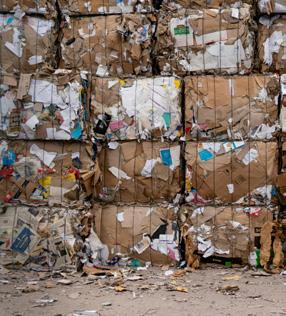

Methane flaring is an effective way to reduce the carbon emissions from landfills
SUSTAINABLE WASTE SOLUTIONS
To the old saying “Death and taxes are inevitable”, I would add a third – trash. As long as modern mankind has been around, he has generated waste, and the problem is getting worse. Is there a solution other than not generating waste?
By Reg Barichievy, Team Leader at Waste Synergy
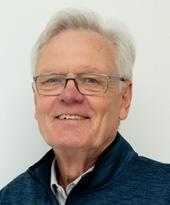
Reg Barichievy, Team Leader at Waste Synergy

practice, we need to change the way we do business. Whilst South Africa is making progress in its efforts to manage waste effectively, it still lags Europe, which may be an unfair comparison because that is the gold standard. We can, however, learn from them and adapt some of their best practice.
One way of keeping a shopping centre clean is to clean it and then lock the doors. Effective but not sustainable. Given that we have to let people in, we need to manage the waste they produce, and the solution needs to be sustainable.
And that is the problem; at the moment,
In Europe, the disposal method has largely changed from landfill to waste-to-energy. Their level of development, resources and climate assist in this. The populations are generally more urbanised than South Africa’s and certainly more aware of waste management. We have very few waste-to-energy plants, and those are not widely commercially available.
Realistically, we cannot expect further funding from the central government in the short term. Some progress is being made in
By understanding where South Africa is, and learning from other country’s successes South Africa can move towards its sustainable goals
waste from the premises as quickly and cheaply as possible. If waste generators start by looking at what they produce and study where it originates, then they will see the bigger picture more clearly and be able to take action to prevent or minimise waste at source.
The solutions depend on the specific business, but there are several principles common to all. Measuring what is coming in and what is going out should be a fundamental management practice. It is only by understanding where and how waste is generated that one can take steps to minimise it. Regular waste audits assist this.
Ensuring that recyclable waste is not contaminated in the collecting process will minimise contamination and maximise the income for the waste generator.
Making staff, clients and stakeholders aware of the drive to sustainable waste management on a global scale and bringing that back to the workplace fosters understanding and buy-in.


The unseen environmental impact of AI
Amazon alone has 100 data centres, Google has more than 35, and Microsoft has more than 100
Sitting at your computer and entering a prompt into ChatGPT feels far removed from the environmental troubles plaguing the Earth. The truth is that AI – especially the data centres used to train them – have a massive environmental impact.
By Duncan Nortier
AI models like ChatGPT require data centres, which have data storage facilities where complex computational scenarios can be run to ‘train’ the AI model. To do this, these data centres require a staggering amount of electricity and water. While data centres have been around since the 1940s, the increase in scale, demand, and number of these centres has raised concerns among climate change academics, and activists alike. Amazon alone has 100 data centres, Google has more than 35, and Microsoft has more than 100.
Elsa Olivetti, professor in the Department of Materials Science and Engineering and the lead of the Decarbonization Mission of Massachusetts Institute of Technology’s (MIT) new Climate Project say that the daily
use of AI is having a far bigger impact than people might think.
The numbers
Training an AI model – the process of setting parameters and performing billions of inputs to fine-tune the AI in order to perform its tasks – is an energy-dense task. To train ChatGPT 4 (the latest model) requires 62.3188 Gigawatt hours (GWh) of electricity, 42 times more than the previous model, and as these technologies become more sophisticated the energy use increases.
According to MIT, in North America, the operation energy of these data centres grew from “2 688 megawatts at the end of 2022 to 5 341 megawatts at the end of 2023, (partly) driven by the demands of generative AI.”
In 2022, data centres globally used 460
terawatts, equivalent to the 11th highest electricity consumer in the world. For context, Saudi Arabia used 373 terawatts, and France used 463 in the same year. By 2026, it is projected that data centres will use 1 050 terawatts, making them the fifth largest electricity consumer, more than Russia. Even after these models are trained, they continue to use more energy than traditional computing. ChatGPT uses 25 times more energy than Google per search.
What next
AI’s daily use has exploded worldwide, and it has already embedded itself in the economy and society. Going forward, the big answers will come from green energy solutions, moving to cleaner energy, and finding creative solutions to offset its impact.




HOW

PICKS IT UP
Established in 2001, Pikitup and the City of Johannesburg entered into a Service Delivery Agreement that mandates Pikitup to provide waste management and refuse removal services to the residents of Johannesburg. The entity is also responsible for resource security, environmental sustainability, and good governance in the CoJ. The resources of the company are directed towards the key strategies and priorities envisaged by the National Waste Management Strategy (NWMS) to reduce, reuse, and recycle waste streams.
Municipal waste management involves not just the act of collection, but actively fighting against illegal dumping, something that is a challenge in the city of Johannesburg. This, along with


Managing waste is the cornerstone of any functioning city. For Johannesburg, South Africa’s most populous city with 4 million residents, this task is done by Pikitup.
changing the environmental landscape, requires more sustainable practices alongside day-today operations.
Combating illegal dumping
Muzi Mkhwanazi, communications manager for Pikitup says, “The fight against illegal dumping is high on our priority list and requires a multiprong approach.” They have highlighted five keyways to manage illegal dumping in the city: 1 Collection
The entity reports that the number one way to prevent illegal dumping is to actively provide refuse removal. “It is key that we provide waste collection services to our residents once a week, both in informal and formal areas. Informal areas are important as they often lack the infrastructure for waste management, and informal settlements represent the chance to really see the benefits of this service.” This service is well planned, and backlogs threaten the entire system, Mkhwanazi says, “We have robust backlog systems in place that prevent and solve them if they do arise.” Part of the collection is communication, and Pikitup states that they send communication out in the event of service interruptions or delays to inform the community of plans to service affected areas. Outside of their mandated collection service, they
have implemented dumping clearance where they actively clean up illegal dumping sites and then provide people within the area with refuse bags, as well as ensure the area remains waste free for up to 7 days. “Prevention is always better than cure, and we have 40 garden sites where community members drop waste. We also offer clean building rubble disposal for free at all Pikitup landfill sites.”
2 Education
and awareness
Human behavior dictates the effectiveness of every public project, and actively shaping human behavior is pivotal to the success of Pikitup’s efforts in fighting illegal dumping.
“Our education and awareness strategy takes on a two-pronged approach which is to:
• Create awareness through education.
• Mobilise the community by building an understanding of good waste management practices which includes the reduction of littering and illegal dumping.
Pikitup’s education campaigns are targeted towards areas where illegal dumping is a problem. They identify the area, engage in dump clear outs, and then actively campaign in the community to change the behavior. “Our campaigns speak to environmental concerns and community health, as well as the legality.”
Getting the community to recognise the problem, report the problem, and selfenforce is key to preventing illegal dumping.” Their campaigns cover the prevention of illegal dumping, dos and
Muzi Mkhwanazi, communications manager for Pikitup
A familiar site in Joburg, these Pikitup trucks are core to providing essential waste removal services, the best way to prevent illegal dumping

don’ts relating to illegal dumping in public spaces, pavements, and curb sides. Alongside these targeted campaigns they also engage in ‘blitz campaigns’ at schools, churches, organised cleanups, and door-to-door. These focus on promoting and educating on waste by-laws, and Mkhwanazi says, “Engaging with the community, especially school children, is the best way to see action and change human behaviour patterns.”
3 Law enforcement
Changing human behavior and other longterm approaches are vital, but the reality is that arresting and charging people is just as
KleenaJoburg100 aims to keep Johannesburg’s city-centre clean and waste free
important in the short term. Pikitup is piloting a 60-person Illegal Dumping Officer squad that works with the Johannesburg Metropolitan Police Department (JMPD) to prevent dumping and enforce the law. Mkhwanazi states,
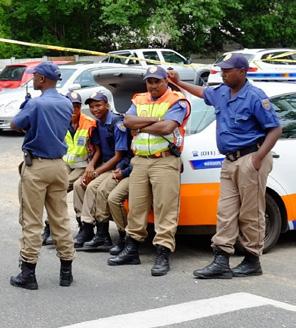
“These officers are permanently deployed in strategic regions. Illegal Dumping Officers work as a conduit between Pikitup and JMPD and act as ambassadors for environmental contraventions. The role of Illegal Dumping
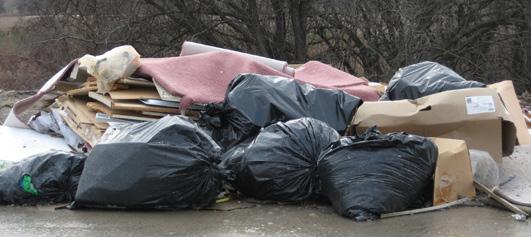

Involving law enforcement is crucial to combating illegal dumping
Illegal dumping is more than an eyesore; it is a health and safety concern
Officers is to carry out regular daily patrols and monitor illegal dumping spots, especially by driving and walking around the spots at regular intervals as stipulated in the targeted service areas.”
4 Partnerships
Mkhwanazi says, “Illegal dumping is not a oneperson issue, nor is it a one organisation issue. We do our best to engage with communities, and we also do our best to engage with other entities, the more people helping, the more successful our efforts will be.” Partnerships are essential for Pikitup’s efforts, and outside of their partnering with JMPD they also partner with community policing forums, residents’ associations, neighbourhood watchers, private security companies and other spheres of
Community vegetable gardens are an effective way to use spaces that were once dumping grounds
government. Partnerships enable the educational campaigns that Pikitup embarks on, as well as create a united front against illegal dumping.
5 Rehabilitation
Illegal dumping is not just about the eyesore, there are serious health and concerns involved and to this Mkhwanazi says, “It would be great if there was no illegal dumping, but there is. Much of our efforts post-prevention are focused on site rehabilitation.” The culmination of their educational and community-based outreach, site rehabilitation identifies areas where illegal dumping is rampant and then implements a community lead initiative where they aim to “create stewardship in the general population.” The CoJ have made the fight against illegal dumping a top priority, saying”


the health, safety and dignity of communities are threatened by illegal dumping,” and by placing the power in the hands of the affected communities allowing them to become stewards of their environment, the fight against illegal dumping becomes easier. Mkhwanazi add that “When service delivery works, and when site rehabilitation is successful communities see the benefit of a clean environment, and in turn they become the biggest actors in the fight against illegal dumping.” Part of the rehabilitation process involves finding a different use for the site. So far, 40 former garden sites have been converted into integrated waste management facilities where recycling is taking place, and the disposal of waste is not limited to garden waste but to other forms of waste streams. The acceptance of other streams of waste in such sites contributed to curbing illegal dumping. In relation to rehabilitated illegal dumping spots, some have been converted into car washes, vegetable gardens, and community parks.
KleenaJoburg100 spots campaign
A new addition to Pikitup’s campaigns, the KleenaJoburg100 Spots Campaign launched in June 2025, where the entity aims to integrate its tactics into one cohesive strategy by focusing on:
• Rehabilitation of Illegal Dumping Sites: The campaign will focus on identifying, cleaning, and rehabilitating 100 illegal dumping sites across the municipality, enhancing the aesthetic appeal of public spaces, and reducing environmental hazards.
• Promotion of Sustainable Waste Management: Through education and awareness programs, the campaign will encourage residents and businesses to adopt responsible waste disposal practices, emphasising the importance of proper waste management in maintaining a healthy environment.
• Community Engagement and Participation: The campaign seeks to foster a sense of ownership and responsibility among community members, encouraging them to participate actively in the identification and cleaning of illegal dumping sites.
• Collaboration and Partnerships: By uniting various stakeholders, the campaign aims to leverage resources, expertise, and knowledge to achieve its objectives, demonstrating the power of collaboration in addressing complex urban challenges
This campaign, spearheaded by the Johannesburg mayoral rehabilitation strategy team, is set to boost Pikitup’s efforts and clean up the city of Johannesburg.
Mkhwanazi expands by saying, “While it is our job to implement action plans, we rely heavily on others; waste management works best when many people are involved and understand the goals.”
Illegal dumping is more than an aesthetic eyesore, it is a threat to community health and a crime
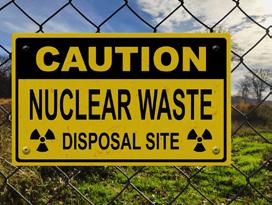


From government to private sector, the message is clear: South Africa’s future energy mix will include nuclear energy. Nuclear energy is a clean and efficient energy source if managed properly, and part of this management is the correct care of radioactive waste. By Duncan
Nortier
MANAGING SOUTH AFRICA’S NUCLEAR WASTE
South Africa is no stranger to nuclear power; the Koeberg nuclear power station in the Western Cape has been generating electricity for the country since 1984. South Africa’s significant research in the pebble bed modular reactor has been instrumental in the current global interest in small modular reactors. The South African Nuclear Energy Corporation’s (NECSA) SAFARI-1 research reactor is used to create medical and industrial radioisotopes. Recognising the potential for nuclear growth, the South African government gazetted the National Radioactive Waste Disposal Institute Act 53 of 2008. This act created the National Radioactive Disposal Institute (NRWDI) as a separate entity from radioactive waste producers
to manage South Africa’s radioactive waste effectively and safely.
Riedewaan Bakardien, CEO of NRWDI, has spent his entire career in nuclear power. He explains “NRWDI exists to ensure that radioactive waste is properly disposed of. Before NRWDI, the government identified that managing and producing radioactive waste could come into conflict with each other. We work together with Koeberg and NECSA but stand alone in our mandate. At the base level we collect and manage waste like any other waste management company, it is just that the waste we manage requires higher safety precautions and stricter regulation.”

Riedewaan Bakardien, CEO of the National Radioactive Waste Disposal Institute
Radioactive waste in South Africa Bakardien identifies three main contributors to radioactive waste in South Africa: 1 NECSA’s SAFARI-1 reactor. This is a 20MW pool-cooled reactor that is used primarily to generate medical isotopes, specifically Molybdenum-99, which is used in over 40 million medical procedures annually. SAFARI-1 is also used for the neutron transmutation doping of silicon, which is useful for the growing semiconductor market.
2 Koeberg power station. Koeberg is rated at 1,860 MW, its average annual production is 13,668 GWh, and it has two turbine generators, each capable of adding 930 MW to the grid.
3 Byproducts of nuclear processes, including from Koeberg and SAFARI-1, that lead to radioactive equipment, materials, and clothes of nuclear workers. This lower-level radioactive items from activities in these
The SAFARI-1 reactor

facilities, over time become too radioactive for continued use and must therefore be discarded.
Bakardien says, “It is not as scary as it sounds. Radiation is part of everyday life; you could be exposed to more radiation on an international flight than working at a nuclear facility for a year. The equipment and clothing simply get to a point where it meets limits for radioactive disposal, that is why we discard and store it.”
NRWDI identifies four categories of radioactive waste in line with the International Atomic Energy Agency (IAEA) standards:
1 No level: This is negligible, equivalent to standard background radiation.
2 Low level: This includes clothing of the workers at nuclear facilities.
3 Intermediate: This is waste that NRWDI currently receives from NECSA and Koeberg and includes plant components, filters, and chemical resins.
4 High level: This is primarily the spent fuel from a nuclear power station
Vaalputs: A Safe Storage Site
“Opened in 1986 by NECSA, and soon to be fully managed by NRWDI, Vaalputs is South Africa’s nuclear waste management site. Located 100km from Springbok in the Northern Cape, the area is suitably remote for its purpose. Internationally, people are envious of the location as it is perfectly suited for the


job in terms of location and soil makeup. Choosing a site was an arduous task and required a lot of data and impact studies,” says Bakardien. The low and intermediate level waste is stored on-site by means of 10-metre-deep trenches that are then buried using compacted soil and the natural clay found in the soil at Vaalputs. In terms of volume, the facility spans 10000 hectares, or 16,5 km wide and 6km long. Bakardien adds, “Over the 40 years of managing low and intermediate radioactive waste, only the area of 2-3 football fields has been used up.”
Because of radioactivity, NRWDI ensures that the containers are packed properly and buried properly. “We need to ensure no migration of waste to the soil and ensure that


Steel drums being transported for trench burial
Koeberg power station
Containers of sealed waste are buried underground in trenches
there are no leaks. It may look simply, but the container material is correctly stacked, and correct burial is done to secure the waste and ensure it remains exactly where it should,” says Bakardien
The future of radioactive waste in South Africa
The high-level radioactive waste, specifically spent fuel from Koeberg and Necsa’s SAFARI-1 reactor, is currently being stored at Koeberg and Pelindaba respectively. Bakardien explains, “This Vaalputs site is not licensed for this waste, but going forward this may change.”
For high-level radioactive waste, the storage options become more difficult. Currently, most of the high-level waste in the form of spent nuclear fuel is securely stored at Koeberg Nuclear Power Plant, in spent fuels pools to allow for cooling. In the medium term, this will be moved to a Central Interim Storage Facility (CISF), the site for which is currently being identified. The NRWDI is in the conceptual stages of developing the Centralised Interim Storage Facility (CISF), which will provide a secure, purpose-built location to house spent fuel before its eventual transfer to a Deep Geological Repository (DGR). The CISFs are designed to safely store radioactive materials for 50 to 100 years, depending on specific needs and conditions.
“South Africa is managing approximately 1,000 tonnes of high-level waste accumulated over four decades of Koeberg operations,” says Bakardien. “In this business we must think centuries into the future, and our long-term plan is to implement a DGR solution, similar to Finland’s model in the next 50 years.”
Working with the IAEA and fellow nuclear waste institutes around the world, NRWDI is researching deep geological repositories which are engineered systems located over 400 metres underground that can safely contain heat-generating radioactive waste for hundreds of years. These repositories represent global best practice in long-term nuclear waste management.
“South Africa is a global leader in spent fuel management and storage,” Bakardien adds. “We adhere to international standards and work closely with local and global nuclear authorities.”


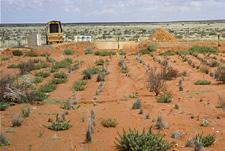

Additionally, NRWDI plans to move Koeberg’s six 380-tonne steam generators to Vaalputs for long-term storage, in support of Koeberg’s 20year life extension. This further strengthens the country’s strategy for safe and sustainable radioactive waste management, in support of South Africa’s nuclear industry.
Nuclear safety and misconceptions
Part of NRWDI's responsibilities is the continual education of communities and industries that work with nuclear waste. “Vaalputs is, to put it casually, remote. We rely on communities close to the site, and when we get highly trained workers at the facility, we ensure that they understand protocol and safety regulations. While the task of transporting and storing waste sounds simple, radioactivity makes it important to always act within regulations and guidelines. We are constantly ensuring that safety is taught and understood to be the overriding priority,” says Bakardien.
Part of this education engagement is communicating the seriousness of radioactive
waste and its effects on people and the environment. Any spillover, migration, or mismanagement could become an environmental disaster for the area. In 1997, it was revealed that some containers had rusted, which led to the National Nuclear Regulator shutting down operations until 2003. In this era of Vaalputs management, Bakardien says, “We are ensuring that operations are always safe and ensure that past events do not recur.” Nuclear energy is part of South Africa’s future, and the safe and effective storage of radioactive waste must be done to support nuclear energy growth. Bakardien concludes, “Nuclear is a catalyst not just for energy development, but also technological development and innovation. The public may have worries about radioactive waste, and if I could get one thing across, it is that NRWDI takes radioactivity, and the safety of people and protection of the environment very seriously. There is nothing to worry about if regulations and protocols are followed. Radioactivity is part of life, and part of the future; it is not something to be feared, rather understood.”

Koeberg currently keeps its spent fuel on site in spent fuel tanks
After site rehabilitation, natural fauna grows over the buried trenches
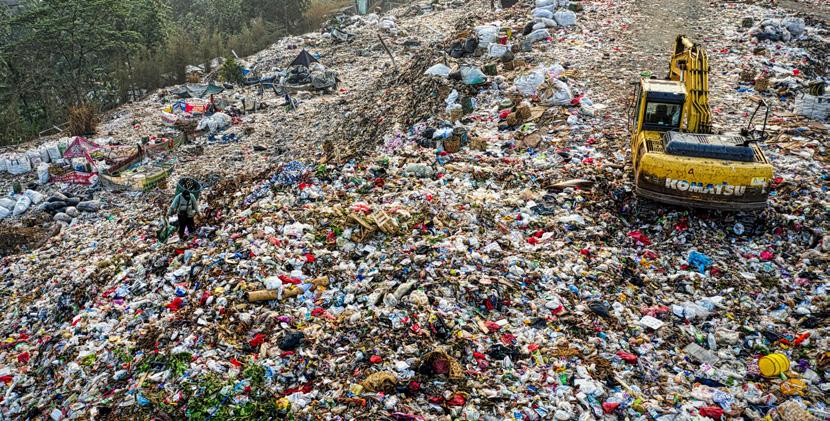
WHAT ROLE CAN
WASTE PLAY IN THE ENERGY CRISIS?
Circularity has everyone looking at how the things we throw away can be of use, economically and environmentally. South Africa also has an energy crisis, and ReSource sat down with Justin Bott, CEO of Interwaste, to ask what role waste can play in the South Africa’s energy mix.

South Africa’s reliance on coal is always tested in times of energy instability. What do you think the role of renewable energy is in the South African landscape?
South Africa’s energy journey must evolve beyond crisis management. Renewable energy is no longer just an environmental imperative –it’s a socio-economic and strategic one.
We have a unique opportunity to diversify the energy mix with cleaner, decentralised and resource-efficient solutions. While solar and wind rightly dominate the conversation, waste-to-energy processes represent an oftenoverlooked, yet readily available source of energy that can supplement traditional renewables – especially during peak demand and in industrial applications. In South Africa we generate an estimate of 122 million tons of waste per annum with 90% of this waste being disposed of to landfills. Much of this waste, if managed effectively, could be re-used as alternative resources in the form of waste to energy solutions which offer a wide range of scalable options for processing waste which could make a significant contribution and reliable source of energy, as well

Justin Bott, CEO of Interwaste
Landfills are still the primary means of waste management in South Africa, and diverting waste to landfills is a prime goal of the circular economy
as alleviate pressure on our natural resources and eco-systems.
In your words, how does the waste sector fit into the broader renewable energy push?
The waste sector plays a bridging role between the circular economy and energy resilience. By converting suitable waste streams into alternative fuels, we reduce the volume of waste to landfill, cut greenhouse gas emissions like methane, and create a valuable energy resource for industries under pressure to decarbonise. But beyond the energy benefits, we also see the waste sector as a custodian of biodiversity. By diverting organics and hazardous materials from land and water systems, we’re actively protecting habitats and supporting the regeneration of ecosystems – especially near landfill and industrial zones.
What does it mean to leverage the energy capabilities of waste?
At Interwaste, we recognise that waste is no longer just a by-product of industry – it’s a resource with real energy value. Many industrial sectors, particularly mining, manufacturing and agri-processing, generate complex waste streams that can be safely and effectively repurposed.
Through mechanical and thermal pre-treatment processes – such as drying, shredding, and blending – we are able to convert selected nonrecyclable wastes into Refuse-Derived Fuel (RDF) or biomass fuel alternatives. These fuels are then used to replace or supplement coal in
high-temperature industrial applications, such as cement kilns and boilers. This not only supports operational continuity during power shortages, but also helps industries meet emissions-reduction targets and improve their overall environmental footprint.
Importantly, this model aligns with circular economy principles – keeping materials in use for longer, reducing landfill dependency, and supporting responsible consumption and production. It also ensures that waste does not end up polluting nearby ecosystems or biodiversity corridors, which are often located close to industrial zones.
In short, leveraging the energy potential of waste isn’t just about solving the energy crisis – it’s about shifting how we value materials, and recognising the broader environmental and biodiversity benefits that come with smarter waste management.
For the energy sector to increase capacity during the winter season – what alternative energy source options do we have available?
Winter always stresses the national grid. While large-scale renewables are essential, decentralised solutions – like RDF, biomass, and biogas from organic waste – offer flexible, short-to-medium term support for energyintensive industries. These options can be deployed faster than traditional infrastructure,
and they leverage waste that would otherwise become an environmental burden.
RDF is a solid fuel source recovered through the shredding and bailing of certain presorted dry industrial non-recyclable waste. The RDF we produces requires no heat for drying, produces a cleaner RDF and a much higher heating value similar to that of A-grade coal, thus forming a very suitable and robust alternative to fossil fuel use. Such fuels can be used within sole/co-feeding plants and replaces conventional fuels (e.g. coal) in production plants for power, steam and heat generation, cement kilns and other suitable combustion installations.
If we use the mining sector as an example again, rubber is one of their biggest waste streams (tyres, conveyor belts, etc) and can be put through an RDF process by using technology to strip out the wire, remove beading of OTR (off the road) tyres, cut in half, quarter and shred down into particular sizes for RDF use in other industries. While this is in its infancy, there is a growing need for it and cost wise, can provide a good offtake for the mining sector if you consider the reuse of existing waste and the savings in carbon emissions and responsible waste management. Other processes such as thermal destruction, gasification, pyrolysis, anaerobic digestion, and landfill gas recovery can also create an energy stream.


Our company has a very successful campaign where we produce alternative fuel - which is generated from blending suitable hazardous waste, such as hydrocarbon and chemical
South Africa’s reliance on coal is something that will shift over time
Organic waste is untapped resource that could produce energy if managed correctly
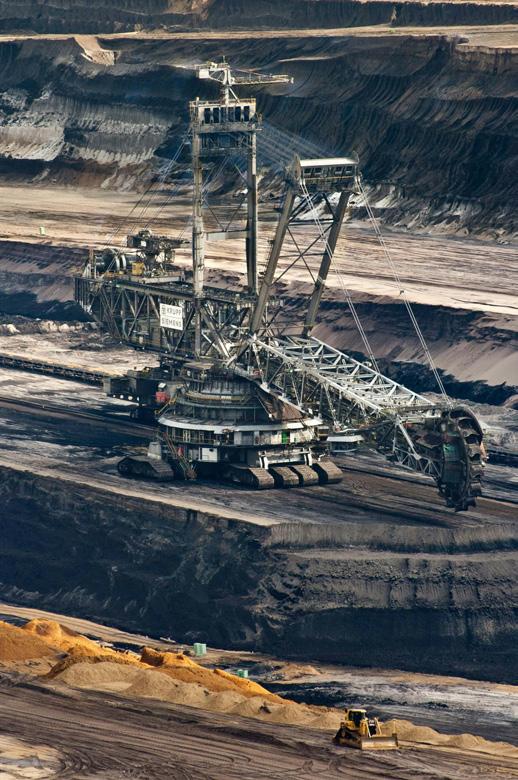
hazardous waste at our facility in Germiston. The alternative fuel is currently transported to cement kilns, where it is then combusted through co-processing. This project is benchmarked to supply up to 1000 tons per month of consistent fuel per kiln. From a mining perspective, while this waste is not going back into the mining sector as yet, mining waste is used in such processing - contributing to a stronger reuse and repurpose mindset within the sector.
Coal vs waste – in what ways is waste an environmentally friendlier energy source?
Coal is extracted from the earth at great environmental cost – land degradation, water contamination, and air pollution. In contrast,

energy derived from waste is about resource optimisation. We’re not digging new holes –we’re closing loops.
Waste-to-energy solutions also support landfill diversion, which is crucial in reducing leachate and methane – both of which threaten biodiversity in surrounding ecosystems. So, when done responsibly and with appropriate environmental controls, waste becomes a circular alternative to coal, not just a cleaner one.
Are there any other waste streams that can be used as an environmentally friendly means to generate energy?
Yes. Organic waste, contaminated biomass, industrial sludges, and used oils all have potential to be repurposed. Through anaerobic digestion, composting, or thermal treatment, each of these streams can be processed into fuels or soil-enhancing by-products.
And importantly, the controlled treatment of these waste types prevents them from damaging ecosystems – from wetland pollution to the destruction of soil biodiversity, which often goes unnoticed.
How can high waste industries such as mining contribute to solving the energy crisis?
Mining companies sit at the intersection of high waste generation and high energy demand – which means they’re well positioned to lead change. By investing in circular solutions and working with waste management partners to process their by-products into alternative fuels, they can both reduce their carbon footprint and create secondary energy sources.
Moreover, rehabilitating old waste sites and engaging in biodiversity offset projects as part of their ESG mandates ensures long-term environmental value beyond energy.
What projects has Interwaste been working on that align with rectifying the energy crisis?
Interwaste has long recognised the energy potential of waste. Our alternative fuels programme supports the manufacture of refuse-derived fuels for use in industries such as cement, where energy-intensive thermal processes are the norm.
We’ve also worked with clients to develop zero-waste-to-landfill strategies that include the energy recovery of non-recyclables – ensuring energy efficiency is embedded in the waste management hierarchy.
At the same time, we continue to invest in infrastructure that protects biodiversity – from leachate control systems to organic composting and bioremediation. For us, the solution isn’t just about energy recovery; it’s about holistic environmental stewardship.
High waste producing industries like mining have the potential to lead the way forward on waste to energy projects
Interwaste works with industries where energy-intensive thermal processes are the norm, such the cement industry, to produce refuse-derives fuels
THE RIGHT SEWER CLEANING EQUIPMENT
can save lives
Sewage is high on the list of topics people would rather forget, but this system is integral to a functioning society, and if something goes wrong then ‘out of sight’ becomes ‘fix this now.’
By Duncan Nortier
If South Africa’s sewers function as intended, then the waste is removed from the home, it travels down the line and into a wastewater treatment plant (WWTP) unobstructed. With regular maintenance there should be no issue. This is however not the case, Sebastian Werner, managing director of Werner Pumps South Africa, says, “South Africa’s sewer systems take a beating. So much waste ends up in our sewer systems, waste that these systems were not designed to take.” From sanitary products, to literal trash everything ends up in our sewer systems which is exacerbated by socio-economic problems. “For illegal settlements with zero service delivery, throwing waste down a manhole seems like a better solution than leaving it out, unfortunately it isn’t great,” adds Werner. There is also the oft cited lack of maintenance on municipal infrastructure that allows build-ups to become serious blackages. “On a recent project cleaning a primary settlement tank in Soweto, the backup was so severe that those on site couldn’t believe what we were sucking up through our trucks.”

The debris from the sewer cleaning is dried in the process of cleaning, and this can be used for fertiliser production

Whatever is thrown into a sewer system stays there. WWTPs are not designed to filter out the sheer volume of waste that goes into them, and the vast majority of extra waste stays in the sewer line causing blockages. Werner explains “Blocked sewers need to be addressed quickly and regularly, and it is a dangerous task.”
Sewer cleaning safety
Municipality were called to unblock a sewage pipe, and in the process died. Werner adds, “Sewer systems are dangerous. They pose significant health risks to those who go into them, and the conditions inside require specialised safety protocols.”
Werner Pumps ‘combi’ trucks which are both jetting and vacuum being used to clear up a primary settlement tank in Soweto
In 2024 three plumbers from the Ekurhuleni

Of course the best solution is to avoid people going into the sewer system, and for this Werner Pumps recommend their truck mounted jetting units.Werner says, “The ideal solution is to remove the risk to human life while still performing the job, using a jetting truck does just that. Modern trucks have built-in features such as gas monitors, and you can also customise your truck unit to ensure it meets the demands of the types of jobs you tend to do. There are also features available, such as remote operation, that allow operators to work from as afe distance, minimising direct exposure to hazards.”
These trucks represent a real solution to the dangers of cleaning a sewer. One of the features available is the ability to reuse water on the truck, constantly cleaning the debris, isloting it, and from this process the dry debris can be used for fertiliser production.
Werner concludes saying, “Technology isn’t just about making the job easier, which jetting trucks definitely do, but it is also about improving the safety of dangerous jobs.”
LOOKING INTO THE

‘ENERGY EFFICIENCY IN PUBLIC BUILDINGS INFRASTRUCTURE PROGRAMME’

Solar power will become an increasingly common sight within public buildings thanks to EEBIP
The National Development Plan 2030 (NDP) is an ambitious document that outlines South Africa’s efforts to grow the country’s economy. Part of this includes a revised look into energy and how South Africa can best go about achieving its carbon-neutral goals.
This focus on efficiency and environmental concerns makes buildings, which generally use a lot of water and energy, a top priority for carbon neutrality. Carbon neutrality is centred around efficiently managing resources, and the Energy Efficiency in Public Buildings Infrastructure Programme (EEPBIP) is the guide for how South Africa’s public infrastructure will function as efficiently as possible.
What is EEBIP exactly?
According to the Department of Minerals and Resources and Energy (DMRE), EEBIP’s main goal is to improve the energy efficiency of public buildings and infrastructure and reduce greenhouse gas emissions. To do this, the programme aims to identify financing and implement energy savings and demand-side management measures in place. EEBIP is concerned with:
1 Buildings owned by municipalities, provincial departments, and state-owned enterprises.
2 Public street and high-mast lighting
3 Waste water treatment facilities
The DMRE states that EEBIP is a mechanism that public building owners and accounting officers will use to improve the energy efficiency in buildings. Depending on the rating a building receives, the building would have to either implement energy-saving strategies to move up the rating scale or continuously minimise its performance to remain highly rated. These energy-saving strategies will be achieved through technical support to the public sector and investment risk mitigation. The programme is key to the NDP as it promotes employment and supports local enterprise development. EEBIP is used in tandem with other government initiatives such as demandside management and energy performance certificates.
EEBIP has set up the Energy Efficiency Project Support Unit (EEPSU) hosted by the DMRE, which will action projects that fall under the initiative, like solar and biogas energy generation. EEPSU seeks out bankable projects that will be tendered out to the private sector under energy
Energy efficiency begins with simple fixes, replacing lightbulbs and ensuring existing energy use is as efficient as possible


performance contract modelling. EEPSU’s mandate is to:
• Identify bankable energy efficiency projects
• Support procurement within the guidelines of applicable finance management and public procurement legislation and regulations.
• Build institutional capacity on energy management, project development, and energy performance contracting.
• Measure, monitor, and verify projects
In the case of all energy-related projects, funding is crucial, and by partnering with the Industrial Development Corporation to provide partial credit guarantee loans. Financial risk mitigation is also available to small, medium, and micro enterprises that are involved with energy-related projects.
Objectives of EEBIP
The programme seeks to increase local economic activities and develop capacity within public entities while involving the private sector, resulting in job creation. While the economic objectives are necessary for South Africa, the environmental objectives will be the means to achieve these goals.
The DMRE envisions EEBIP’s outcomes as follows:
• A 4.3 Metric Ton of carbon dioxide equivalent (4.3MtCO2e) reduction in greenhouse gas emissions.
• A total of 1800 jobs in the energy-saving field.

The EPC certificate will have seven ratings, G being the worst performing and A being the best performing
• Increasing the energy-saving market by 50%
• Generate R380 million in public finance
• Generate R1.1 billion in private finance
Energy performance certification
While EEBIP focuses on public buildings, the DMRE also outlines plans for private building ownership. Building owners and accounting officers who own or manage buildings with an area greater than 2000 m2 of privately owned floor space and less than 1000 m2 of government-owned floor space will have to submit a certified copy of their building’s energy performance certificate (EPC) to SANEDI before the 7th of December 2025.
An EPC is a document that displays a building’s net measured energy consumption in kilowatt hours. This performance is then measured against a benchmark of other buildings in the occupancy class and area. This is the first time that accounting officers and building owners will be obligated to publicly share their energy consumption.
The penalty for non-compliance will be either a fine not exceeding R5 million, imprisonment for a period of not more than 5 years, or both.
The EPC process
The DMRE suggest that all building owners determine their need for an EPC. If the building in question falls within the need to submit an EPC, the DMRE recommends appointing a SANAS-accredited professional to conduct the assessment. The registered professional will conduct the assessment in line with SANS 1544:2014 and upload the data onto SANEDI’s system, which will issue a unique EPC number. This must then be displayed on the premises and a certified copy sent to SANEDI within 3 months of the issue date. These will be randomly spot-checked by the DMRE and are up for renewal after 3 years.
Both private and public entities are set to transform over the coming years, and having buildings comply with more stringent laws will be a guiding mechanism in driving energy efficiency.










Coal power still makes up most of South Africa’s energy mix, and communities rely on them for indirect employment
A CASE FOR

NUCLEAR

South Africa’s transition to renewables is underway. The Just Energy Transition (JET) sets out the plan for South Africa’s carbon neutral future, but there is a glaring question that remains: what replaces base load? By Duncan Nortier
Baseload refers to the minimum power needed to meet consumer demand, and renewables cannot compete with coal on this front.
Wandile Shezi, a PhD Student at the University of Johannesburg, says: “Diversifying the energy mix and incorporating renewables is important, but in reality, South Africa is a developing country, and the scale

through renewables alone.” This may sound like ‘going against the grain’ but in reality this is a common view shared by CEO of the South African National Energy Development Institute (SANEDI) Dr Titus Mathe who says: “Renewables are important, but we need to look at replacing baseload if we really want to get serious about our low-carbon goals.”
The key to South Africa’s energy transition is the inclusion of ‘Just,’ this reframes this transition as one that actively understands the socio-economic landscape of South Africa. Coal is important to South Africa. “We cannot ignore that South Africa was built by coal. Jobs, towns, legacies are all tied to coal,” adds Shezi. The misconception that renewables can simply replace coal is compounded by this socio-economic factor. The move to a more sustainable energy network must be accompanied by secure jobs, and upskilling.
Wandile
Shezi, PhD Candidate
at the University of Johannesburg and member of the South African Young Nuclear Professionals Society
“Entire communities are built around coal, whether its mining, or power production, and taking that away without backup is a recipe for failure, especially considering that renewables do not replace baseload,” says Shezi. “Renewables are supplemental, or additive, right now with our current technology it simply can’t compete,” adds Shezi.
Komati power station, a lesson learned
Komati power station served as a pillar for the community that surrounded it. This power plant was commissioned in 1961, and was planned for decommission in 2017, but only actually decommissioned in 2022. The decommissioning came about through a $497 million loan from the World Bank. This loan was to be used for the realisation of JET.
However, in the years since the decommissioning, reports, and interviews from grassroots movements, such as the Khutala Environmental Care Group, alongside trade unions within the energy sector, say that Komati has endured a severe economic downturn. While many direct Eskom employees could be moved to different stations, Komati acting general manager Thevan Pillay claimed that the station was supporting 3 000 to 4 000 people with jobs or contract work when it was operating. The station served as a hub for various towns around the site, and the decommissioning led to a sharp increase in unemployment.


At the time, Eskom chairperson Mpho Makwana described the development as a major step forward in South Africa’s Just Energy Transition to renewables.
He emphasised that the funding would enable Eskom to train both its employees and members of surrounding communities, equipping them to remain actively involved in delivering clean energy for the country. The World Bank noted that the project had the potential to serve as a model for a just energy transition not only in South Africa, but globally.
“Pinning the hopes of renewables on a single project in South Africa was not in the country’s best interests, including making South Africa the poster child for renewable energy in Africa. While funding and international cooperation are essential, South Africa needs its own framework and processes outside of European standards to ensure its own future,” says Shezi.
A 2023 presidential report stated that Komati failed due to:
• Lack of cohesive planning from Eskom and government departments.
• Poor timing and sequencing in the closure of the Komati power plant.
• There was an absence of meaningful engagement with local communities, and workers in the decision-making process.
• The project had a narrow scope, leading to significant job losses with limited economic opportunities for communities around Komati. Thevan Pillay stated that there were significant problems with developing the site. “We cannot construct anything. We cannot remove anything from the site.” Major challenges included difficulty in securing funding and delays in receiving regulatory approval for repowering and repurposing. These issues significantly stalled job creation, re-skilling initiatives and the provision of social support. “Our jobs ending traumatised us
Koeberg nuclear power station has been operating in South Africa since 1961 and creates thousands of jobs every year
Nuclear is seen as a much greener alternative to coal, with the UN saying without Nuclear, carbon neutrality is out of reach

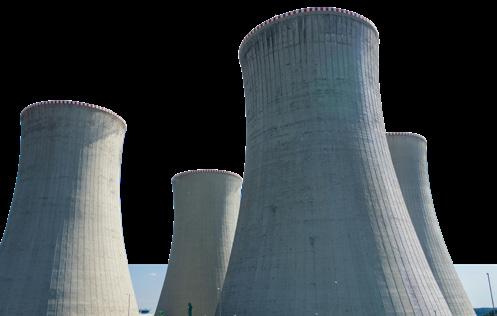
South Africa’s weather makes it an ideal candidate for renewable energy, but it is costly and currently does not compete with the generation capacity as coal
a lot as a community,” says Sizwe Shandu, a former boilermaker at Komati since 2008.
On-the-ground situation:
• Only a few small green projects are underway.

• There have been widespread job losses.
• Minimal upskilling or training offered.
• Sharp decline in local economic activity.
What can South Africa do?
Shezi, a member of the South African Young Nuclear Professionals Society (SAYNPS), says, “Nuclear persists as a viable solution as the generation capacity is one of the few sources that can compete with coal, and the scope of nuclear projects can provide avenues for upskilling and employment in
a similar way that coal power plants do.”
South Africa has one functioning nuclear power station, Koeberg, and according to a 2017 KPMG report, the station provides 2 300 direct jobs and 42 000 indirect jobs per year in the Western Cape. This should be seen as an optimistic look at what nuclear could do for South Africa. Nuclear is also much greener than coal, Shezi adds, “The fact is that nuclear, done well and properly, is green. The United Nations, who were previously hesitant to call nuclear ‘green’ are now singing the praises of nuclear to decarbonise.” In a 2024 speech the UN’s atomic energy division stated, “Without nuclear, decarbonising by 2050 is impossible.”
Shezi concludes with “The best time to start building nuclear power plants was 10 years ago, the next best time is right now.”

Retail accounts for 20% of the GDP of South Africa; it is a massive industry, and it is going through a shift. This shift emphasises sustainability and circular practices that not only reshape the retail landscape but also help ease the conscience of conscious consumers.
Sustainability in retail

Sustainability is at the forefront of Woolworth’s identity, and they ensure that customers are aware of and understand their sustainable business practices as a core part of their offering. For 20 years, Woolworths has embarked on its ‘Good Business Journey’ programme that seeks to implement sustainable practices at every point in the Woolworths value chain.
Packaging
Food packaging is a real issue if left unmonitored. People need to eat, and food packaging is necessary for food safety. A Woolworths spokesperson says, “We begin the design phase. We need our packaging to be food safe, and consider the quality, weight, and recyclability

of the packaging. Over the years, we have replaced or removed unnecessary packaging, such as plastic cutlery, plastic straws, certain fruit trays, and of course, single-use plastic shopping bags.”
Woolworths’ packaging team’s strategy ensures recyclability where possible, avoiding overpacking, and buying local packaging whenever possible.
As much as Woolworths brand products are thought of, they also consider privatelabel products. Vision 2025+ forms part of the ‘Good Business Journey’ and aims
Woolworths made the decision to pull single-use plastic bags, and in 2024 saved 40 million from landfill
The AxelPower truck uses kinetic energy to from driving to power its onboard refrigeration unit
to address the complex and interconnected sustainability challenges the retail brand faces. Part of Vision 25+ is ensuring all privatelabel products are reused, repaired, resold, or recycled by 2025. The company also aims for at least one renewed, reused, or recycled material input by 2030. On this, the Woolworths spokesperson says, “We are on track to meet our 2030 goals where packaging is concerned. The macro context of these challenges is outside of our control, such as scarce skill sets or low investment, but this has improved in recent years due to legislation moving the industry. We work within a complex cross-sector ecosystem, and we are on track with our internal goals.”
One of the big wins Woolworths has achieved is saving over 40 million single-use plastic shopping bags from going to landfill in 2024 alone, an outcome they are proud of and one that has a real environmental impact.
Renewables
Renewables form part of Woolworth’s sustainable vision too. The spokesperson says, “To date, Woolworths has installed solar systems at its head office in Cape Town and various distribution centres. In the past year, we generated over 2 million kWh in renewable energy and purchased 7.2 million kWh in renewable energy. At Head Office, the new solar installations are expected to triple the capacity of the initial systems set up in 2013, adding an additional 357 kilowatts. This will bring the total capacity to 465 kilowatts and enable the head office/support office to generate about 11% of the building’s energy needs, including our data centre, to be met through solar power.” Beyond this, the company also announced an additional R17 million investments into renewable energy projects, including solar installations and other renewable energy agreements, that improve the use of renewables across their value chain.
Their spokesperson adds, “We are working with the renewable energy industry, energy traders, retail landlords, government, and local municipalities to make this shift. Our energy goal

encompasses not only switching to renewable energy but also maximising energy efficiency.”
Electric Vehicles
Using Electric vehicles (EVs) reduces carbon emissions. This is a fact, and Woolworths aims to have net-zero carbon emissions by 2040, so they rolled out EVs in two categories: online home deliveries and long-haul freight refrigeration.
“Woolworths partnered with DSV and Everlectric for electric panel vans that deliver food to homes upon order,” says the Woolworths spokesperson.
Additionally, they partnered with DP World for their AxlePower long-haul refrigeration trucks. These trucks use a specially designed axle that converts kinetic energy into electricity, which














powers the refrigeration unit on a long-distance truck. Woolworths predicts a saving of 27 tonnes of carbon emissions each year due to this technology.
The Woolworths spokesperson reports, “There has been negligible downtime since inception, and our 42 EVs save over 400 tonnes of tailpipe emissions annually. Each EV panel van has a range of 300 km at full charge and performs as well as, and due to regenerative braking in some cases, better than a patrol car.
As retail gears for shifts in sustainability, Woolworths offers a case study of how cleaner production is both economically and environmentally beneficial and hopefully paves a way forward for one of South Africa’s biggest industries to adapt to circular practices.


Woolworths EV panel vans save 27 tonnes of tailpipe emissions per year
THE INDUSTRIAL SYMBIOSIS PROGRAMME THAT IS HELPING BUILD THE CIRCULAR ECONOMY
Circularity forces the fast-paced and harsh business environment to slow down, and foster collaboration where there previously was none. The peak of this collaborative process is industrial symbiosis, the process of having the waste of one business become a resource for another. By Duncan Nortier
Industrial symbiosis involves the exchange of resources – materials, energy, water, and by-products between different industries to maximise resource efficiency and reduce waste. This network of collaboration can lead to mutual economic, social, and environmental benefits for all companies involved. While this practice is relatively new in South Africa, the concept has been developing behind the scenes for years.
In 1992, at the Rio Summit, numerous countries agreed to actively find solutions to the looming environmental issues facing the globe. From this, United Nations programmes set up support mechanisms for developing nations, including cleaner production centres. This led to the establishment of the National Cleaner Production Centre, South Africa in 2002.
Since its inception in 2002, following the World Summit on Sustainable Development, the NCPC has sought to bring circular practices to South Africa, and in 2015, it launched the Industrial Symbiosis Programme (ISP).
Tiwa Dune, a project manager for the ISP at NCPC, says, “It started as a pilot project with a UK-based company, for an initial five years. The success of and demand for industrial symbiosis means that the NCPC has been able to expand the programme, and has no signs of slowing down.”
South African policy has had circularity in its mind for a while, and Dune adds, “If we look at our legislation, we can see the National Waste Management Strategy has circularity built into its models, and industrial
symbiosis is one of those strategies that promote circularity through practice.”
How does the ISP work?
In the implementation of an industrial “synergy,” the NCPC acts as a facilitator. Dune elaborates, “We play the role of an intermediatory. Sectors, industries, and companies often operate in strict competition and in isolation, meaning that they may not be aware of ways they can connect with other businesses within the

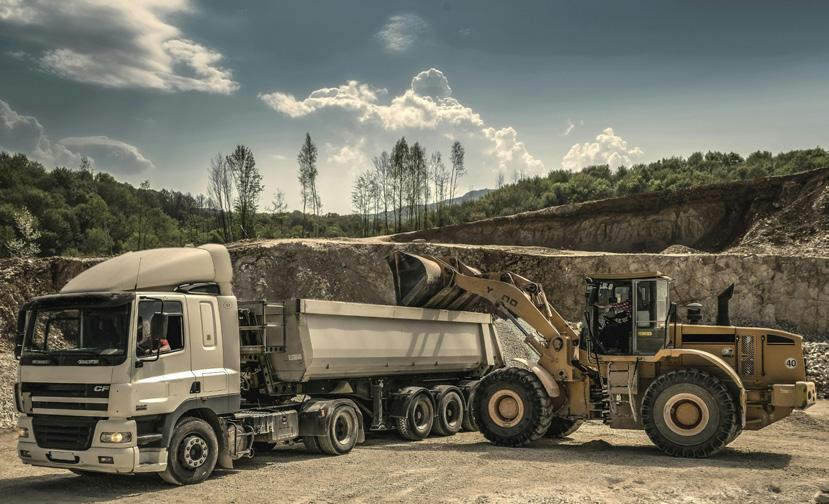
Logistics is a vital part of industrial symbioses, something the NCPC helps businesses with to facilitate the process
Former South African president Nelson Mandela at the 2002 World Summit on Sustainable Development which led to the opening of the NCPC
Organic waste is a significant byproduct of the agricultural industry, which, through industrial symbiosis, can be turned into new products
same sector or in competing markets. Our job is to connect these disparate elements, find synergies, and encourage sustainability along the way.”
The process the NCPC goes through involves identifying waste streams as potential resources and uses a custom-built data management system to link those resources with others who can use them. Once the NCPC has identified a potential constructive collaboration, they approach companies or whole sectors to begin the process of determining the supply, the price, and logistics of the waste. They will then look for offtakers who can use the waste as a primary resource. “If the market is correct, those involved are willing, and the supply steady. We then begin the process,” says Dune.
There are other factors to consider, and Dune adds, “For a business to be considered, they must be operating legally, and within regulation. If the waste is hazardous, we would need to articulate this and our part in educating and ensuring training for managing hazardous waste. The NCPC often relies on the expertise and testing infrastructure of its host, the Council for Scientific and Industrial Research (CSIR), to make informed decisions in this process.
We then negotiate with the businesses involved to reach a fair agreement between them. We are constantly monitoring the market for pricing and trends so that we can help these businesses make informed decisions.”
Aside from facilitating, the NCPC is also tasked with technical reporting. For industrial symbioses to help with sustainability, it needs to be economically viable. The reporting phase examines the data from both ends of the transaction. “As we receive data and monitor the activities, we track and report everything so that the businesses involved can see the benefit


and future businesses to see the results and trust the process,” says Dune.
The environmental impact of this circular practice is highly persuasive. To date, the NCPC has diverted an estimated 518 000 tonnes of waste from landfilling, thus mitigating approximately 1.7 million tonnes of greenhouse gas emissions.
A national effort
Industrial symbiosis falls into the broader plans of the Department of Forestry, Fisheries, and Environment (DFFE), and an agreement between the two allows for the NCPC to share the reporting data with the DFFE.
The NCPC is the custodian of the industrial symbiosis programmes in eight provinces, and Dune explains, “We work closely with provincial governments. They have the regional knowledge that helps us do our work. They have access to waste data and problems that may need fixing, and we rely on them for these insights. We usually approach the economic or environmental division, whichever deals with waste, and sign a memorandum of understanding. They point us in the right direction, and we then begin our process.”

Circularity in progress
TNK Greenhouse, a small enterprise based in Ka-Maqhekeza in Mpumalanga, takes biowaste from agriculture, carbonises the waste in a kiln to create biochar. TNK Greenhouse then mixes it with water and maize and presses it into briquettes. These briquettes are an eco-friendly solution to the coal-based briquettes used all over
Tiwa Dune, project manager for the ISP at NCPC
South Africa. Over a nine-month period, TNK Greenhouse diverted 577 tonnes of waste from landfills, mitigating 160 tonnes of greenhouse gas emissions, while saving R27 000. They report, “The NCPC has been instrumental in helping us understand the importance of collaborating with key industry players. They have provided tools to measure production quantities, conducted laboratory tests to ensure industrial quality standards, and mentored us in maintaining business relationships through the Industrial Symbiosis Programme.
TNK Greenhouse Technology is privileged to partner with the NCPC and the CSIR, as these stakeholders are essential in developing our business professionally and maintaining quality.” Industrial symbiosis is capable of circularity in action, proving that new ways of sustainability are also economically viable.

Eco briquettes produced by TNK Greenhouse say the NCPC’s ISP is vital to their success

This PVC 200 mm pipe used 45% recycled plastic in its middle layer. While this pipe did pass the 1000-hour pressure test, it is still not suitable to transport drinking water due to the possibility of material migration

public health and infrastructure reliability. Despite repeated warnings, the association reports that the use of sub-standard “80/20” pipes – made with 80% virgin material and 20% recycled material – is still prevalent in the local market.
He points out that the relevant HDPE pipe standards only allow for the inclusion of reprocessed material originating from a manufacturer’s own, in-house production scrap. Since no pipe manufacturer generates 20% internal waste, any pipe labelled as 80/20 will, by default, contain external recycled material – making it non-compliant with the national product standards and SAPPMA’s Code of Conduct.
Tests using recycled plastics
RECYCLED PLASTIC IN PIPE MANUFACTURING: THE DANGERS AND OPPORTUNITIES
The move toward circular business practices has led to an interest in using recycled material wherever possible. This is economically and environmentally sound, but the use of recycled material has its limits, specifically when using recycled plastics in water pipes.
The Southern African Plastic Pipe Manufacturer Association (SAPPMA) is firm that recycled plastic cannot be used in pressure pipes. Pressure pipes are used to transport drinking water, gas, and wastewater when a system cannot rely on gravity. These pipes must be able to withstand pressure for extended periods of time and be reliable in the long term – 50 years or more.
Plastic and its use have been at the centre of sustainability issues, so why is it that recycled plastic is not an answer for these circumstances?
Under pressure
Peter Sejersen, technical manager of The European Plastic Pipes and Fittings Association (TEPPFA), says, “the first issue we run into is that not all plastic for recycling is made equal. It is difficult to control the
By Duncan Nortier
quality, and cleanliness of this plastic so recycling it would yield a plastic that is not as durable as virgin material.”
TEPPFA is the European equivalent to SAPPMA, and even when relying on Europe’s robust recycling initiatives there is room for error. “Having full control over the quality of plastic used in recycling makes a positive impact – however, recycled plastic still doesn’t match the durability of virgin plastic,” adds Sejersen.
Jan Venter, CEO of SAPPMA, cautions that using recycled plastics in high-density polyethylene (HDPE) pressure pipe violates both international and national standards (ISO/SANS 4427-2). The practise is not only illegal but also poses a significant risk to
Peter Sejersen, technical manager of The European Plastic Pipes and Fittings Association (TEPPFA).
Pipes must undergo a pressure test to test their “hoop strength,” and this is where plastic made for this purpose shines. A pilot study in Denmark tried three different 110 mm pressure pipes, one with 25%, one with 60%, and one with 75% recycled materials. All three failed the pressure test. The study then repeated this with a 25% recycled material pressure pipe using pelletised plastic and this did allow the pipe to pass the 1000hour pressure test, but Sejersen adds, “only barely.” It is important to note that this pipe had a ‘brittle failure’ as opposed to a ‘ductile failure’ once again highlighting that recycled material is not suitable for pressure pipes.


Jan Venter, CEO of SAPPMA
Other pipes with varying degrees of recycled material were tested:
• 315 base, 200 mm connection pipe using 60% recycled material. One connection passed, the other failed the 1000-hour pressure test.
• PE Twin Wall, 315 mm pipe. One with 100% recycled material in the outer layer, and one with 50% in the outer layer. Both production runs failed the 1000-hour pressure test.
• PP 200 mm pipes with 45% recycled material. These failed the 1000-hour pressure test.
• PVC 200mm with 45% recycled material on the middle layer: This passed the pressure tests
Sejersen stresses that, “Some of the products did pass the pressure test, if only barely, but it is also important to note that recycled material is not suitable for drinking water pipes. Drinking water must be clean and be free from any plastic migration from the pipes. When using recycled materials, you do not know the source and it could be coming from packaging materials from pesticides or other toxic substances. These substances will migrate into drinking water making it unsafe.”
“The use of recycled material from external sources in pressure pipe systems is strictly prohibited for a reason. It drastically compromises the performance and lifespan of the pipe, and when used for potable water, it could have serious health implications. Our industry cannot afford to cut corners for the sake of cost-saving. The long-term risks and financial consequences are simply too high,” Venter warns.
The opportunities of recycled plastic
While not suitable for pressure pipes or drinking water pipes, recycled plastic can be used in non-pressure pipes not used for drinking water. Non-pressure pipes are used for sewers, stormwater, as well as land and building drainage.
“As the world embraces circularity and sustainability, there is a definite use for

recycled plastics in non-pressure pipes. Our tests show the theme to be perfectly suited for this job,” says Sejersen, “it is also important to understand why we should look at recycled plastic where possible.”
“The manufacturing of plastic pipes accounts for nearly half of the carbon dioxide of an entire project including installation,” says Sejersen. From this understanding, the use of recycled materials where possible becomes imperative to carbon savings. This is also where the introduction of biobased materials or chemical recycling – a process that transforms plastic to oil – can be used to mitigate the harm of plastics used in pressure pipes. “While nonpressure pipes can benefit from recycled plastics, we must still look into reducing the impact of pressure pipes by means other than traditional recycling.”
In Europe, plastic production is decreasing while in Africa it is increasing. Drawing
CONSEQUENCES OF USING RECYCLES PLASTIC IN PRESSURE PIPES INCLUDE:
• A drastically shortened operating life, resulting in unexpected and costly failures.
• Disruption of critical services due to premature pipe bursts or leaks.
• Health risks, especially when used to convey drinking water.
• Legal and reputational risks associated with transgressing standards.

on Europe as an example, in 2022 they produced 400 Mega Tonnes (MT) of plastic, while recycling 50 MT of plastic in the same year. South Africa produces about 2,5 MT of plastic per year and recycles 430 000 tonnes (0,4) MT. Both places are comparable as Europe recycled 19% of its plastic production, and South Africa recycled 17% of its total production.
This figure shows that there is room to grow, and using recycled plastics in nonpressure pipes is a step forward to reduce South Africa’s carbon impact.

Testing a 315 mm twin wall pipe with 50% recycled material
The 110 mm pipe with recycled material showed a brittle failure, this illustrates that this pipe is not suitable for pressured environments
New data shows liquid board carton and PET plastic recycling in SA is on the rise

South Africa’s recycling initiatives under the extended producer responsibility (EPR) legislation are proving positive. PETCO, a producer responsibility organisation (PRO), published its annual review stating that they have met the legislated targets for 99% of the tonnage of identified products placed on the market by its members in 2024.
Petco, representing 29 major brands including Coca-Cola, PepsiCo, Tiger Brands, and Tetra Pak, reported strong progress in its recycling initiatives, saving 76,000 cubic metres of landfill space in South Africa – equivalent to filling 2 324 six-metre shipping containers.
CEO Telly Chauke announced that Petco met all government-set targets for its extended producer responsibility (EPR) schemes, especially celebrating the success of its relatively new liquid board packaging (LBP) programme.
“We’re particularly delighted with the success of our new EPR scheme for liquid board packaging, which saw us achieve a more than 200% increase in its collection and recycling rate last year,” Chauke said. “In only our second year, we’ve collected and recycled three times the volume compared to 2023.”
The growth in LBP recycling, now at 24% and 26% for collection and recycling, respectively—up from just 8% – is credited to strategic investments in infrastructure and a model that builds sustainable value chains. This mirrors the success of PET bottle recycling, which has climbed from 16% in 2005 to nearly 76% today.
A 2024 focus is Petco’s partnership with Tetra Pak to deploy buy-back centre liaison and regional recycling officers to improve LBP recovery nationwide. These officers strengthen ties between waste pickers, municipalities, and recyclers to tackle regional collection challenges.
“Petco’s distinct value offering to members is having a team on the ground dedicated to ensuring the flow of materials to our recyclers,” Chauke added. Last year, this team conducted over 200 activations at buy-back centres across all provinces.
LBP, which consists of 75% paperboard and 25% poly-aluminium, is being repurposed into products like school desks and low-cost building materials. Petco’s approach includes supporting recyclers

with feedstock, stimulating end-use demand, and growing processing capacity.
In 2024, Petco invested R70 million into the value chain, enabling recyclers to buy R470 million worth of packaging from small businesses. “We recognise that SMMEs are key to unlocking higher volumes of quality recyclables,” Chauke said. “Our support equipment, mentorship, and training also help unlock economic value for the marginalised.”
Petco trained over 4 700 people through awareness workshops and accredited business training, and equipped 47 SMMEs. It also partnered with 59 municipalities to strengthen local waste systems.
“Working with government is a key aspect of the Petco model,” Chauke noted. “It helps scale and sustain initiatives, allowing producers to meet obligations and municipalities to improve infrastructure.”
“Ultimately, growth is Petco’s driving force –expanding our reach and capacity to strengthen South Africa’s circular economy while keeping valuable packaging out of the environment.”
In 2024, producer responsibility organisation Petco achieved a 200% increase in the collection and recycling rates for this recyclable packaging

Koos Rapulane of Boikanyo Lesedi Environmental Waste Management surveys a mountain of liquid board cartons collected for recycling
CEO Telly Chauke
The industry standard
for
getting ‘dirty’ water to a suitable drinking standard requires chlorine, but chlorine has its limits. Treating water in rural places requires easy solutions, and non-chlorinated water treatment may be the answer to this necessity.
A new way of
Verona Bowie, managing director of Ezemvelo Eco Solutions, says, “If South Africa keeps doing the same thing over and over, we are not going to get out of our water issues. We need to try innovative approaches, and while ‘new’ is sometimes scary, we must embrace it.”
Ezemvelo offers a range of non-chlorine water treatment products designed to address South Africa’s water challenges.
Why not chlorine
While chlorine remains the standard, there are some problems with the chemical. “There are certain bacteria that are chlorine resistant, and in areas where water is extracted from a river, the elevated levels of organic matter can render the chlorine ineffective and thus harmful to drinking water. In the past, the solution to bad water was to increase the dosage of chlorine, but it cannot be pushed any further without completely wrecking the water quality.” In terms of wastewater treatment, if the water pumped back into the water source is not of adequate quality, it has adverse effects on the rest of the water.

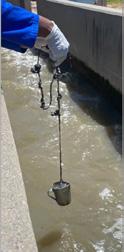



Chlorine systems rely on centralised water management, and in South Africa’s rural areas, this does not exist. “Put simply, people need water; some people do not have access to water, so the solution is to get clean water for people who need it. The shortcomings of chlorine mean we need an easy-to-implement solution for areas and plants where chlorine cannot help,” says Bowie.
Non-chlorinated water treatment

Rubicon Eco is an environmentally friendly disinfectant that disinfects water without forming disinfectant by-products (DBPs). DBPs can be harmful and, in some cases, carcinogenic, and the absence of DBPs is essential for the health and safety of Rubicon Eco’s use. “Rubicon Eco can treat water for spores, bacteria, viruses, fungi, most common pathogen organisms & phenols and combating diarrhea diseases such as cholera, typhoid fever, and E. coli,” says Bowie.
This product is well-suited for municipal wastewater treatment, where its use replaces chlorine and treats water to a tasteless, odourless clean state. Prolonged storage shows that the

only decomposition materials are oxygen and water, a claim substantiated by the World Health Organisation, Water Research Commission of South Africa, and international bodies such as BSRC Japan. “Rubicon Eco oxidises cyanide, sulfur, as well as amines. It can also be used in arsenic remediation,” adds Bowie, who continues, “It is also effective in treating water with antibiotics present. As drug-resistant bacteria and antibiotics are more common in water, Rubicon Eco is capable of clearing water from these bacteria as well as antibiotic-polluted water. “
After extensive testing, Rubicon is already on the market, and Bowie says, “The need for an efficient water disinfection that is able to target all levels of pollution while being environmentally safe is important for the South African context, and as chlorine reaches its cap in the use non-chlorinated products are a solution that makes sense.”
Rubicon in use
In South Africa, several municipalities are conducting field tests with Rubicon Eco as a substitute for chlorinated purification in wastewater treatment systems. At this stage, the municipalities involved were happy with the demonstration and this field test will go a long way to develop the data for potential wastewater treatment use.
In other African countries the feedback on the Rubicon sachets has been positive, with many reporting that the sachets provided essential relief in rural areas where centralised water treatment is not available.
Water being collected and treated with Rubicon Eco at a wastewater treatment plant
Before and after two minutes of dirty water being treated with Rubicon sachets
Verona Bowie, managing director of Ezemvelo Eco Solutions
The UN estimates that the human population will grow from 8 billion to 10 billion by 2050. This extraordinary figure forces the world to reckon with one of its biggest challenges, namely, how do we ensure food access for these billions of people?
By Duncan Nortier
Already, 28%, 2.4 billion people, face moderate to severe food insecurity. In South Africa, 15 million people face food insecurity, yet the country produces 10 million tonnes of food waste every year. There is a general problem with how our food is produced, how this food is distributed, and how this food is wasted.
Humans make up 34% of all mammal biomass on earth, wild animals account for 4%, and livestock and pets make up 62%. For birds, 71% of all bird life on Earth is poultry. The scope of this problem is global; it is not just a case of getting food to people, but ensuring that our food sources are stable and fed.
The waste sector has sought solutions to organic and food waste that aim to add value and introduce this waste back into the economy via circular practices, either through composting or technology like anaerobic digestors. Nowadays there is new technology on the market, Cobus Kotze, CEO of Nutrisek, a black soldier fly farming company, says, “Turning organic waste into a high value product with black soldier fly (BSF) larvae is a relatively new technology, it’s been around for about 15 years but it offers a unique solution that aims for circularity and addresses food directly.” Cobus adds that, “If we look at the problem, food waste is a near $1 trillion issue every year, and if food waste were a country, it would be the third highest greenhouse gas emitter.”
The opportunity Converting waste into both animal feed and fertiliser is a chance
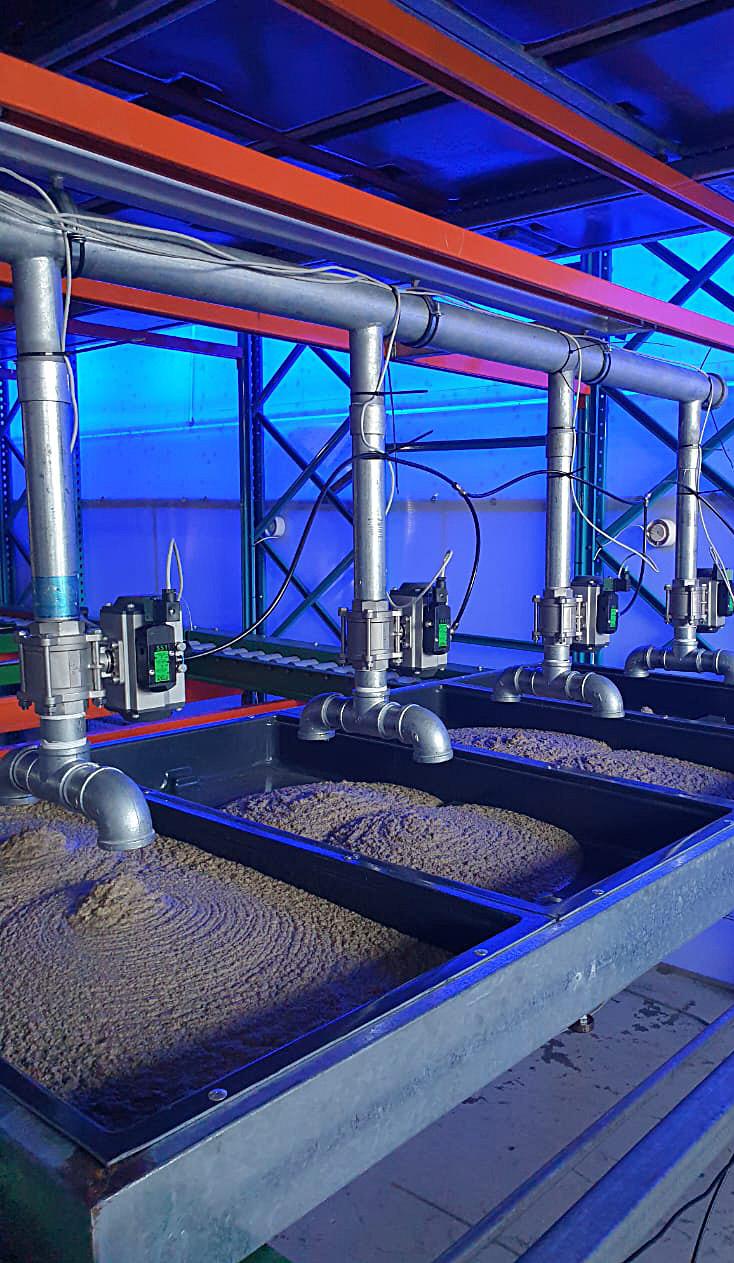

WASTE
to FOOD to feed From
to reintegrate some of society’s more wasteful activities back into the economy in a way that matters. This cycle would take waste, process it to become feed for livestock and pets and fertiliser, use this feed and fertiliser to grow more food, both animal and plant, and
Cobus Kotze, CEO of Nutrisek
then any waste produced from here can go back into this system. “Valorising this waste stream in a very sustainable fashion helps solve many problems. From a municipal angle, this waste is diverted from landfill, from an ecological angle. This waste becomes a sustainable food source for animals, and from an economic angle, the value added creates jobs, and a market for this waste stream,” says Cobus.
“The process,” Cobus explains, “is relatively simple. Waste is introduced as a supply; BSF larvae are added to this waste, and as they
feed, they upgrade the nutrients of the waste into protein, oil, and fertiliser. The bioreactor comprises two steps: the lifecycle of the BSF and the grow-out process of adding eggs to waste.”
The end result of this bioreactor process is three distinct products:
1 Insect protein: A high-protein feed that can be used to sustain livestock.
2 Oil: The BSF is fatty, and if harvested this high in nutrients, oil can go into pet food and aquafeed. Cobus does say that it could be used for biodiesel, but this is expensive and unlikely.
3 Fertiliser: The larvae leave behind frass, a mixture of insect excrement and exoskeletons, that makes for a good natural fertiliser.
Why the fly?
The star of the show is the black soldier fly (BSF). A non-invasive species, the BSF larvae break down bacteria and emit an odour that repels other pests, and once they are adults, they do not have mouths, so they do not seek out crops or food waste after the larval stage. The scalability of this process also means that it can be done at various price points and offers a decentralised approach that can meet problems where they are.
Valorising organic waste
The value of this technology is attached to how easy it is to obtain and operate, Cobus explains, “Our bioreactor, named Hive 20, is aimed at adding value. When we talk about waste solutions other than landfill, there are capital requirements, and legislation that can make things difficult. So, we decided that if we are serious about this, we will ensure that Nutrisek will have its economic benefits upfront. The size and scalability of Hive 20 means that the process is as cheap as it can be. It is also modular and easy to deploy, so start-up can happen quickly upon receiving the Hive.”
For the future of this technology, he says, “I understand that not everyone wants to become a fly farmer, some of our clients are interested in managing waste, and this just happens to be a way of doing it. We enter longterm service agreements that cover technical support and maintenance, and we offer to buy back the larvae produced from the process. We envision municipalities using this technology, and their mandate is to collect, transport, and manage waste. We do not want to give extra work; we want to give them a solution for this waste stream.”
The environmental impact
This process is circular as well as sustainable. Nutrisek’s BSF bioreactor offsets 3 000 tonnes of CO 2 emissions per reactor annually. This
The star of the show is black soldier fly whose larvae might bring food security to the world

is equivalent to 600 hectares of rainforest offsetting and 200 tonnes of soy production for a fraction of the time, capital, and land space.
“We are currently working with an Australian company that farms BSF, which is the first commercial plant in Australia. We have global reach, but we are focused on home, South Africa, and are in talks with various companies, organisations, and municipalities to get the technology to where it is needed most,” adds Cobus.
Food waste is a massive loss when considering the food insecurity of the world and using this waste to increase resilience and maintain the human population’s food source, such as livestock, is one way of securing food and providing for the future.
Livestock accounts for 62% of the animal biomass on Earth, and poultry accounts for 71% of all birds. Ensuring that they are fed feeds us in turn

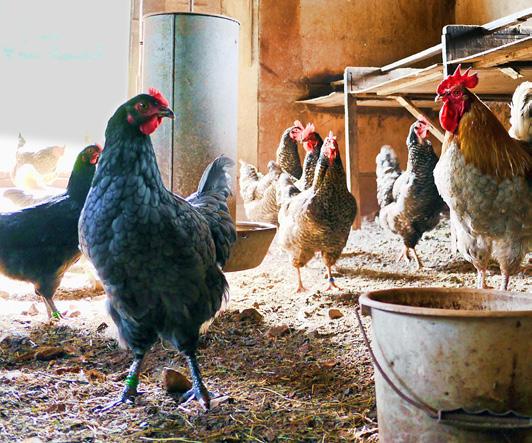
The BSF larvae upgrades the nutritional value of organic waste into valuable products
GREEN BUILDINGS: a holistic path towards greater sustainability
Green buildings play a vital role in advancing South Africa’s circular economy. By promoting energy and water efficiency, reducing waste, and retrofitting existing structures, they create jobs, lower environmental impact, and support sustainable growth.
The built environment is the human-made surroundings that shape human activity, encompassing everything from individual buildings to entire cities and their infrastructure. “It is important to see the connection between the actual building, its purpose, and how it shapes human activity. This is where green buildings become important as they represent a fundamental shift in the way the built environment acts on those who use it.” says Lisa Reynolds, CEO of the Green Building Council South Africa (GBCSA). A green building, according to Reynolds, serves its purpose while being as sustainable as possible for that purpose. This entails allowing the people who use it to also act sustainably.
The GBCSA certifies green buildings, as well as promotes sustainable practices and green technologies, and advocates for better policies. Reynolds adds, “Our current legislation is the minimum, and the drive towards green design is voluntary. The GBCSA acts as an independent third party, enabling us to evaluate buildings and projects as they are, ensuring a standard.” Certification and rating are crucial to avoid greenwashing. Buildings that do not have the GBCSA’s certification while claiming the green building title are unevaluated and thus the claim holds little weight. Reynolds adds, “A ‘green building’ is not just a name, it is measurable. It is important to note that when we discuss sustainability, we need real, quantifiable definitions.”

Buildings designed to be sustainable from inception will become more common as South Africa achieves its ‘green’ goals

‘Going green’ does not require vast spending, it can be as simple as fixing leaks
What makes a green building
Simply put, a green building is one that maximises its efficiency in terms of water, energy, and waste. Reynolds elaborates, “Green buildings are designed by assessing their operating processes and making them more efficient. If a building uses a lot of water for instance, then grey water and reuse is considered to lower the amount of water needed. If a building produces a lot of waste, then that waste must be recycled or repurposed in some way.”
The need for sustainable and efficient buildings is heightened by climate change, and the need to be resilient. The example Reynolds uses is that if a building is destroyed by an extreme weather event, and rebuilt the same, then it will be as likely to suffer damage in the future.
The rating system that the GBCSA uses varies from project to project and is context specific. Buildings that are designed to be sustainable from inception are rated differently to those which are not. The scope of this rating process ensures both new and old buildings can be rated and evaluated on their own merits.

Retrofitting
“Modifying existing buildings to become more efficient is just as important as designing with sustainability in mind. South


Green buildings are measurable, and are defined against criteria to avoid greenwashing
Africa’s many buildings represent a chance to create employment and aid the growth of the circular economy through retrofitting existing buildings,” explains Reynolds. The misconception that efficiency involves a huge capital investment is undercut by the simple ways a building can be run more efficiently and sustainably. She goes on to say, “You do not have to begin by throwing solar panels on everything, you can start small. Ensuring leaks are fixed, changing bulbs to energy saving bulbs, have timers on geysers, ensure that anything broken is fixed.”
The GBCSA has a rating system for existing buildings that improve on sustainability, and Reynolds says that the employment opportunity here is huge, “As this practice gains popularity the need for skilled operators, maintenance, and contractors increases, and South Africa has a strong construction sector so the process of upskilling is easy and more importantly accessible.”
How green works
The practical application of these philosophies is abundant. Shopping centres require lots of energy, water, and produce a lot of waste. They represent the ideal building to showcase what green buildings can do. According to a Tourism Board report, the Eastgate shopping centre in Bedfordview sees 2 million shoppers a month. The amount of people generates tonnes of organic waste each month, and to combat this, Eastgate has an onsite composter. The composter can process 40 tonnes of organic waste a month. One tonne of methane is eliminated for every four tonnes of waste processed. This has saved Eastgate on waste transport costs, noting that this onsite composter requires no additional operational cost.

In the case of water, the GBCSA says that for a building to be considered ‘water saving’ it should minimise consumption. This can be done by installing water-efficient fixtures and fittings (low-flow showerheads and toilets) and designing buildings that use less water in their operations, such as those that recycle water or capture rainwater for reuse. Buildings are also evaluated based on their ability to reduce water wastage and promote water conservation using efficient irrigation systems and other water-saving measures. This practice is amplified by good water management that assesses the implementation of water management plans, monitoring and reporting of water usage, and the engagement of building occupants in water conservation practices. These two practices should also take water quality into account; any treatment or reuse must be biologically fit for purpose and adhere to the safety standards set out in South African legislation.
Green practices are also heavily reliant on including people into the design and use of a building, Reynolds says, “Sustainability is not about winning awards, there is a socio-economic benefit to protecting our resources and ensuring the people who use these buildings are safe. Including people and educating them helps ensure sustainable practices work. Recycling only works if people use the recycling bin.”
She concludes, “Retrofitting and designing green buildings is becoming more popular as the cost saving element becomes apparent, and this in turn will generate more jobs while building upon the circular economy for a more sustainable South Africa.”

High organic waste producing spaces like shopping malls, can add composting to their operations which offsets waste to landfill and makes the building more sustainable
Lisa Reynolds, CEO of the Green Building Council South Africa
SA’s biggest onsite waste team powers business sustainability
EnviroServ’s fleet of specialised waste transport vehicles provide a safe, efficient and compliant solution for moving liquid, sludge and dry waste from customers’ premises to waste processing facilities
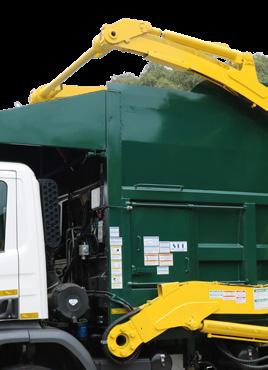

Reducing landfill waste is a core focus for EnviroServ. Their onsite team applies innovation and technical expertise to help businesses reduce, reuse, and recycle more effectively. Kirsten Kely speaks to Yolandi Holm, national onsite manager, about how they support businesses in shifting from linear to circular systems.
EnviroServ’s onsite waste management team is the biggest in the country, and has the biggest pool of staff in the company; reiterating the company’s dedication to reducing waste to landfill.
“Whenever a new customer approaches us for assistance, we begin with a site assessment to understand how their waste is being generated, the volume produced, and its final destination. Next, we identify, analyse and classify waste streams. A waste management plan is then developed, with costing. Waste streams, like glass, plastic and cardboard are the easiest to recycle, then there are other waste streams which are more complex, and therefore, relatively expensive to divert from landfill. EnviroServ typically has readily available solutions for most waste streams and with its wide
network, will actively research alternative options where needed,” says Holm.
Different waste streams
EnviroServ has case studies of diverting waste from landfills across industries, and recently helped a company in the petrochemical industry reduce its waste to landfill by 30%.

Approximately 3 500 tonnes of waste that was sent to landfill on a monthly basis has now been diverted to a brick maker that can use that waste stream in their manufacturing process. Another example is diverting problematic plastic with high calorific valuevalues to cement kiln. There is a small company that makes
school bags and handbags from chip packets. EnviroServ is particularly strong within the fastmoving consumer goods markets, where food waste is diverted to animal feed companies.
Sometimes, through green procurement – the practice of purchasing goods and services that have a reduced environmental impact—can significantly reduce waste to landfill. Selecting products with minimal packaging, prioritising reuseable, durable goods or using recyclable, compostable materials are some examples. “A client of ours reduced a significant volume of waste by merely buying washable plates for their canteen instead of using polystyrene boxes,” says Holm.
“We always make a point of revisiting our existing customers’ waste streams as new technologies are developed. Often, achieving
Yolandi Holm, national onsite manager, EnviroServ
zero waste to landfill comes at a high cost. But that cost will be reduced as new solutions are developed, or become available closer to the source of the waste,” states Holm.
She adds that transporting a waste stream across the country to divert it from landfill would firstly be expensive and secondly have a larger carbon footprint than merely sending it to landfill. “These are the types of options that need to be considered when creating a waste management plan. With that in mind though, there are waste streams where landfills remain the only option, like asbestos.”
Separation at source
A successful recycling operation requires good, clean, uniform collections of segregated waste types. This is most effectively achieved by separating the waste streams close to source, rather than at a waste treatment facility. EnviroServ therefore usually stations a full-time person at a customer’s site that is responsible for receiving all waste and correctly separating it. They act as the custodian for a customer’s waste management. Equipment is provided to ensure the correct handling (packing, labelling, loading), storage and transportation of waste streams.
EnviroServ’s fleet of specialised waste transport vehicles provide a safe, efficient and compliant solution for moving liquid, sludge and dry waste from our customers’ premises to waste processing facilities.
“Part of our on-site waste management services include a monthly sustainability report. In order to create a waste management plan, we need to understand a customer’s sustainability goals. They may want an annual improvement on their landfill rates or they may set up an
EnviroServ usually stations a full-time person at a customer’s site that is responsible for receiving all waste and correctly separating it
MEET YOLANDI HOLM, WASTE WARRIOR AND NATIONAL ONSITE MANAGER
Tell us about your career journey so far: I hold an Honours degree in Psychology and started my career as a school teacher, a role I fulfilled for eight years. I then joined EnviroServ to lead the Schools’ Recycling Programme, before moving into a sales position. From there, I became a project specialist in the onsite department and was later promoted to National Onsite Manager.
What do you love about your job? I often feel like I have a front row seat to the Discovery Channel’s ‘How it’s made’ documentary series. We need to understand a customer’s manufacturing process before addressing their waste streams. And I frequently witness the manufacture of chocolates, cars and beverages. I get to work across diverse industries, and no two days are ever the same. Best of all, I know the work I do makes a real difference to both people and the planet.
What advice would you give to someone joining EnviroServ? What you put in is what you get out. We have great managers that are always willing to consider the ideas you put forward.
Any hobbies? Cycling and fitness
How has your job impacted on your personal life? I cannot cycle past a factory or business without glancing at their bins, trying to figure out what waste they generate and where it goes.
Surprising fact about yourself: I am an introvert.
ambitious target of zero waste to landfill. We collaborate with our customers to establish key performance indicators and then track progress in meeting those targets. Then we measure everything and all of that data will be included in the monthly sustainability report that will show, for example, the amount of saved water, energy and landfill space saved,” explains Holm.
Waste avoidance and waste reduction are achieved through education and trainingby improving efficiencies and making staff environmentally aware. EnviroServ’s onsite waste management team assists in incentivising and training a company’s staff to assist with these goals.


Compliance and expertise come first
EnviroServ, as a waste management company operating in South Africa, must adhere to the National Environmental Management: Waste Act, 2008 (Act No. 59 of 2008) and support the National Waste Management Strategy (NWMS), which covers waste management from ‘cradle to grave’. Customers can therefore have peace of mind knowing that for years, EnviroServ has handled waste responsibly and continues to do so.
“We will only partner with recyclers that are fully licensed and compliant, we protect our clients’ reputation. Our company also has unmatched expertise in the industry,” concludes Holm.
EnviroServ is particularly strong within the fast-moving consumer goods markets, where food waste is diverted to animal feed companies


Once waste is seen as a product, throwing it away is like throwing away money
The reality is that recycling efforts are still subject to market conditions. It does not matter how innovative or environmentally positive a recycling effort is if there is no market for it. South Africa’s recycling sector needs to look at itself realistically to achieve its goals.
How effective market research will shape
the circular economy
South Africa has a waste problem, and if we just replicate what is being done without considering the data to inform decisions, we won’t make any headway,” says Reclite SA’s Managing Director, Steffen Schröder. He goes on to say, “The problem starts with how we conceptualise waste. If you look at waste as just waste, you will miss the fact that it is a product

itself. Instead of mining waste for one specific resource, a comprehensive approach will alter the way you see it. For example, the push to retrieve metals from batteries leaves out the other components that could also generate value.” Schröder calls this perspective shift, waste-to-product, underlining that waste is a resource if treated as one.
Batteries
Recovering metals from lithium batteries only works with certain batteries, and Schröder explains that in the South African market, the majority of the batteries are lithium iron phosphate batteries, which do not contain the valuable metals that make this waste stream positive. He says, “These batteries do not have the required materials to turn a profit, and lithium alone is not enough for a positive waste stream. Old school thinking then says, ‘this isn’t viable’ but if you look at the whole battery as a product and not waste, there are many recoverable items.” Even the way batteries are processed does not reflect the circularity promised by recycling. “A lot of companies will use a pyro-metallurgical process to recover
materials. This is just a fancy way of saying they burn the battery, which not only has a large carbon footprint, but it also destroys most of the battery to recover very little. We are not after just one fraction of the battery, so we use a hydro-metallurgical process to recover the entire battery.” This recovers graphite, which has an active market and is available in all batteries, not just some. By looking at what the battery is made of, and not mining the usual high-value materials, Reclite SA can process and sell graphite steadily.
Renewables
The renewable market in South Africa is poised to grow. The domestic solar market is estimated to grow by 34% between 2023 and 2028, and as more solar panels are used, more will have to be discarded. “Renewables have their maximum impact if they are managed correctly. It does not help that solar is a clean energy resource if the panels are not disposed of and processed correctly,” adds Schröder. While glass can be recycled, the real value of solar panels lies in the silicon layer, the layer that actually produces energy.
Reclite SA’s Managing Director, Steffen Schröder
By extracting the silicon, there is a chance for true circularity; one panel of silicon can be used to produce another.
Schröder says, “There is also potential in recycling the composite materials that are found in wind turbines. The true test for potential lies in understanding waste as a product and using proper market research to see where the potential can go.”
Understanding the market
Schröder explains that testing management solutions usually follows:
• A pilot test: This tests the technical solution or innovation for accuracy and results. “If you produce a solution, you test it here. See if it works,” says Schröder.
• Artisanal stage: If the pilot test proves positive, the solution can be used in small batches, which will result in more efficient processes and put the technical solution into practice.
• Industrial: If the artisanal stage yields positive results and the solution is economically viable, then there is space to scale up the process and have it used at a larger scale.
South Africa has no shortage of technical solutions and innovation, but to avoid wasted capital and projects ending, Schröder says, “The trick is to do your research. Technical solutions are great, and artisanal use of these solutions is also great, but only a few can really be scaled up for widespread use. You must understand what the market wants and your supply before scaling up. In some cases, artisanal solutions are fine as they are, and scaling them would result in financial losses, so it would be better to keep
problem. Schröder calls this ‘an economic approach to production where waste is seen as the primary resource.’
A long-term approach to sustainability
Sustainability is not a short-term goal, and therefore, sustainable solutions should work towards long-term goals.
“As an example, fluorescent bulbs contain rare earth metals, and everyone is crazy about recovering these metals. Reclite SA conducted a pilot test and expanded to the artisanal stage, and then we left it there. Now there is a solution, and there is a market, but the machine you would need to process these rare earth metals at an economically viable rate costs millions, and the disposal process for the acids required is also costly. And now for the biggest problem, there is a ban on this kind of fluorescent lighting. So, the market has an extremely limited supply, and it cannot grow,” says Schröder. Technical solutions are subject to regulation and the market, and in this case, it made the recovery of rare earth metals non-viable.
Solar panels represent a chance for circularity, as the silicon in one panel can be reused in another

Wind turbines are made of composite materials which present an opportunity to recover and remarket
Reclite SA saw this trend and instead found a new way to valorise the waste and sell it on the local market. This did not require capital and is a sustainable approach to recycling this product.
“By using the same supply but focusing on a


Florescent lightbulbs might not return on rare earth metals but thanks to market research Reclite SA were able to find a new market for them

GREEN HYDROGEN CAN ‘REPOSITION’ AFRICA WITHIN GLOBAL VALUE CHAINS
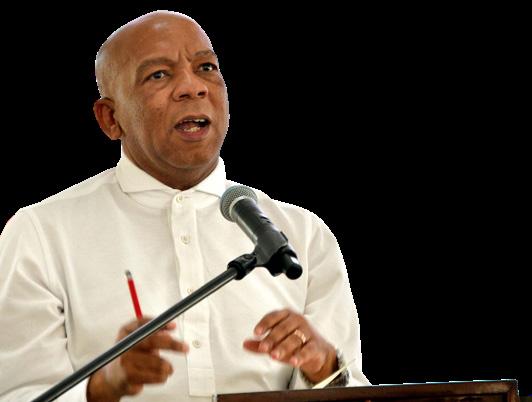
The burgeoning green hydrogen industry presents an opportunity for Africa to enable structural change and reposition the continent. This is according to the Minister of Electricity and Energy, Dr Kgosientsho Ramokgopa. The minister delivered remarks at the African Green Hydrogen Summit, which is underway in Cape Town.
Green hydrogen must be understood not merely as a clean fuel, but as a strategic enabler of Africa’s structural transformation. It holds the potential to reposition the continent
within global value chains, not as an exporter of raw materials but as a competitive industrial actor. Harnessed strategically, it can anchor new industrial ecosystems, from green steel and fertilisers to sustainable mobility and synthetic fuels.
“These are not abstract possibilities -- they are within reach, provided we design policy frameworks that localise value, deepen intraAfrican trade, and direct investment flows towards infrastructure, skills, and technology transfer that serve the interests of the continent,” says Ramokgopa.
Minister of Electricity and Energy, Dr Kgosientsho Ramokgopa
Green hydrogen can be an economic byproduct of renewable energy projects

Green hydrogen
The colour ‘green’ prefixed with hydrogen signifies the level of sustainability and manner it is produced.
Blue hydrogen is produced from natural gas, using a process called steam reforming, which brings together natural gas and heated water in the form of steam. The output is hydrogen, but carbon dioxide is also produced as a byproduct. So, the definition of blue hydrogen includes the use of carbon capture and storage (CCS) to trap and store this carbon.
Blue hydrogen is sometimes described as ‘low-carbon hydrogen,’ as the steam reforming process does not avoid the creation of greenhouse gases.
Grey hydrogen, the most used and produced form available. Grey hydrogen is the same as blue hydrogen, but without the use of carbon capture and storage.
Black and brown hydrogen is produced using coal, and represents the least environmentally friendly way to produce hydrogen.
Green hydrogen is made by using clean electricity from surplus renewable energy sources, such as solar or wind power, to electrolyse water. Electrolysers use an electrochemical reaction to split water into its components of hydrogen and oxygen, emitting zero carbon dioxide in the process. Green hydrogen is expensive, which is why the world is looking to markets like South Africa to produce it at a competitive and available rate.
The potential for South Africa
The industry presents a lucrative opportunity for the continent and boasts a global potential of at least $300bn in global exports over the next three decades.
Africa holds minerals and metals that are critical for industry, placing the continent at the heart of this new frontier.
“More fundamentally, green hydrogen offers an opportunity to reverse the logic of dependency that has historically defined Africa’s insertion into the global economy. Instead of reinforcing extractive patterns, Africa can lead with an agenda of beneficiation, regional integration, and sovereign industrial development.
“This will require that we reject siloed national approaches in favour of coordinated regional frameworks, leveraging platforms like the African Continental Free Trade Area (AfCFTA), the Programme for Infrastructure Development in Africa (PIDA) and, most crucially, Agenda 2063.
“These frameworks offer the institutional scaffolding for a common energy market and harmonised regulatory regimes that can attract patient, long-term capital,” Ramokgopa said.
The minister implored African leaders at the summit to be ‘unapologetic’ in taking their place at the forefront of the green hydrogen global industry.
“We must also be unapologetic in demanding a fair place at the green negotiating table. Africa’s role in the global energy transition cannot be one of accommodation. It must be one of agency. Our narrative must be led by African voices, grounded in African realities, and committed to African futures.
“As the world seeks new energy alliances and supply chains, Africa must shape its energy destiny through solidarity, strategy and statecraft, turning the promise of green hydrogen into a pillar of continental prosperity,” he insisted.
The summit also launched the Africa Green Hydrogen Report –a document thrashing out the continent’s green hydrogen potential, which brings together the full breadth of the continent’s technical readiness.
“This is not just a theoretical compilation; it is a technical blueprint for scaled project execution. Its message is unequivocal: Africa is not short of
knowledge. Africa is ready to move from pilot to pipeline, from strategy to scale.
“But let us be clear. The window for Africa to shape the rules of this emerging market is narrowing. Other regions are moving fast, with public subsidies, regulatory incentives, and long-term offtake strategies. If we delay, we risk importing technologies, importing skills, and once again exporting unprocessed potential.
“So, the real work of this summit is to forge clarity on the scale of our ambition, the credibility of our plans, and the coordination of our actions. Let us begin that work today, with urgency, with unity, and with a shared conviction that Africa’s future is not on the periphery of the global green economy, but firmly at its centre,” he said.
According to the African Green Hydrogen Alliance (AGHA) – which is made up of 10 African states, including South Africa – the industry has the potential to add between $66 billion and $126 billion to the Gross Domestic Product of the member countries over the next 25 years.
Furthermore, some two to four million jobs could also be added during that time.
“Africa’s choice is whether to be a passive site of resource extraction or a proactive architect of the green energy economy. With the right policy frameworks, investment enablers, and regional coordination, green hydrogen can and must be the backbone of a new African industrial era,” says Ramokgopa.

In Snake Park, the evidence of sickness is written in gold dust. Its source towers over the Soweto neighbourhood: a mine dump, loaded with toxic metals, relics of an era when South
By
Africa produced about a third of the gold ever mined on Earth.
the Bhekisisa Centre for Health Journalism
The toxic storm brewing in
Soweto’s Snake Park
The mining companies left behind what’s known as mine tailings, hazardous waste that has damaged the health of nearby communities. And now, with climate change, the dump is even more dangerous, leaving residents caught between an environmental disaster of the past and the gathering storms of the future.
Community activist Thokozile Mntambo is gearing up for battle. Her weapons of war: a laptop and a questionnaire. She and her fellow volunteers have gone door-to-door in Snake Park, interviewing their neighbours; young and old, people living with disabilities, parents who have children with disabilities and those with chronic illnesses like asthma and lung cancer.
For her, the evidence of sickness is painfully personal.
The science behind the sickness
“My sister gave birth to a child with cerebral palsy,” she told Bhekisisa’s TV programme, Health Beat. Mntambo works with the Bench Marks Foundation, a nonprofit that monitors multinational companies, on community training and workshops.
“My mom passed away because she had breathing problems. My brother has asthma. I’m also asthmatic.” Every time Mntambo goes to the clinic, they ask if she smokes. “I don’t smoke, but they can see when they’re doing X-rays, there’s a lot of dust in my lungs … and it’s not only happening to me, it’s happening to everyone.”
Years of scientific research support her concerns.
“It’s a gold mine dump, and scientists that have measured the contents of those mine dumps have found arsenic, lead, mercury,”
says Angela Mathee, chief specialist of the South African Medical Research Council’s environment and health research unit.
Lead exposure alone, she explains, has been associated with cognitive issues such as reductions in IQ scores, difficulties in learning and violent behaviours. But it also damages the kidneys, and because of that, says Mathee, “there’s a higher risk of high blood pressure and in turn, a higher risk of cardiovascular disease”.
A 2024 Canadian study of about 1.5-million mother-baby pairs backs up Mntambo’s belief about the polluted air and her niece’s cerebral palsy. Researchers found a link between the mother’s exposure to air pollution during pregnancy and cerebral palsy in the baby.
This research, of course, doesn’t mean there’s proof that Mntambo’s niece’s cerebral palsy was, without a doubt, caused by the mine

The mine dump that is the source of health problems for the Sowetan community of Snake Park

tailings dams in her community. But it does confirm that there’s a link between dirty air and babies being born with the condition in these environments – and underscores the urgent need for research like this to be sped up.
And the extreme heat that comes with climate change is increasing these health risks.
“For example, in someone who has asthma, an attack is often triggered by air pollution,” says Caradee Wright, a public health specialist who leads the climate change and health research programme at the Medical Research Council.
“When it’s very hot, [the body’s] ability to [deal with] heat is compromised because the person faces an existing health challenge.”
Studies show that air pollution alone is associated with a 5% increase in death rates, while heatwaves are associated with a 6% increase.
“You might naturally expect that if the two are combined – so if you are exposed to air pollution during a heatwave – you’d have an 11% increase in mortality,” Mathee told Health Beat. “But what those studies in Europe show, unexpectedly, is that instead, you have a 21% increase. So it’s just this shocking, unexpected mortality rate that
Mine dumps pose a health risk if not managed properly
just shows the cumulative impact of those two scenarios on health.”
The changing climate also threatens the physical stability of these toxic sites.
Eric Mokuoa from the Bench Marks Foundation warns of catastrophe.
“We have global warming, this environmental catastrophe that is now happening, where you have extreme heat, extreme rains,” he says, pointing to a crack that has already formed in the tailings dam, something that could be further damaged by flooding. “The worst case scenario with the extreme weather is for it to entirely break into that community.”
New era, new threats
The answer should be to clean up the dumps. That’s what Mntambo and her friends tried to do by planting sunflowers that would soak up toxins from the soil. But now, she says, they’re not allowed on the dump, and the sunflower project has died.
“Companies are not consulting [our] communities, but they receive mining licences while communities are being affected by the environmental degradation,” Mntambo says,
pointing to Pan African Resources, which is listed on the London Stock Exchange, and now holds the licence to re-mine the site.
“Our concurrent environmental rehabilitation of these historic tailings deposits is already improving air and water quality in the area,” the company touts on their website.
Company spokesperson Hethen Hira told Health Beat that the rehabilitation process began in October 2024, and that it is planning a health check later this year to see if there’s any risk from radiation. Hira also said that independent reports, that Bhekisisa has seen copies of, found that “the facility was assessed to be safe and not in danger of collapsing”.
For Mathee, the urgency is clear: “We’re living in a new era with new threats, and so we need new standards, and we need new approaches to the protection of public health.”
In Snake Park, those new approaches will need to include the community’s voice.
“We want change, and we want people in communities to be involved in decision-making,” Mntambo told us. “You don’t just come with a jargon of papers and expect people who are illiterate to read 100 copies of the environmental

Studies show that air pollution alone is associated with a 5% increase in death rates

assessment. It doesn’t make sense. Make it simple for communities to understand.”
After Health Beat aired in November, representatives from Pan African met with Mntambo and Mariette Liefferink, the founder of the Federation for a Sustainable Environment (FSE) which has been fighting for the rights of communities affected by mining for 18 years, at a coffee shop in Krugersdorp. They promised to hold community workshops, conduct health tests and work on better
When not handled correctly, mine waste becomes hazardous to the community, and proper mine closure is necessary for the health of communities near them
controlling the dust that ends up in the homes and lungs of the residents.
Since taking over, Pan African says they have cleared the channels around the tailings to help direct excess rainwater away from spilling into nearby homes.
On January 31, Pan African hosted a followup visit from the Church of England Pensions Board and other investment partners in the mine, along with Liefferink, to check on the improvements on the site.

Climate change threatens to worsen
the already
damaging effects of hazardous mine waste

The next step in the process to re-mine the area is an environmental impact assessment (EIA) –a detailed investigation of how mining will affect the environment and nearby communities.
But Pan African says it won’t re-mine the Snake Park area for a few years because it’s so far away from their plant. “However, the ongoing remedial work will ensure rehabilitation is maintained and minimal impact to the environment,” says Hira.
Mntambo says in January she was invited to a “capacity-building” workshop hosted by Pan African’s representative, where several local nonprofits were trained on how to formally register their groups and raise funds for their work. The health problems caused by mining were not discussed.
“We eat your dust. We find it in our food. We find in our houses each and every day, and since you have started building the sand walls and cutting the trees, the dust has become more effluent in the community.”
This article is based on Bhekisisa’s Health Beat programme on climate change, which was broadcast on eNCA on November 24 2024, as well as follow-up interviews conducted by our team in March 2025. The quote from the MRC’s Caradee Wright is from an October 29 2023, Health Beat programme on lung disease and air pollution.
The Bhekisisa Centre for Health Journalism is an independent media organisation that specialises in narrative, solutions journalism focusing on health and social justice issues across Africa. isiZulu for “to scrutinise” and produces evidence-based journalism.












